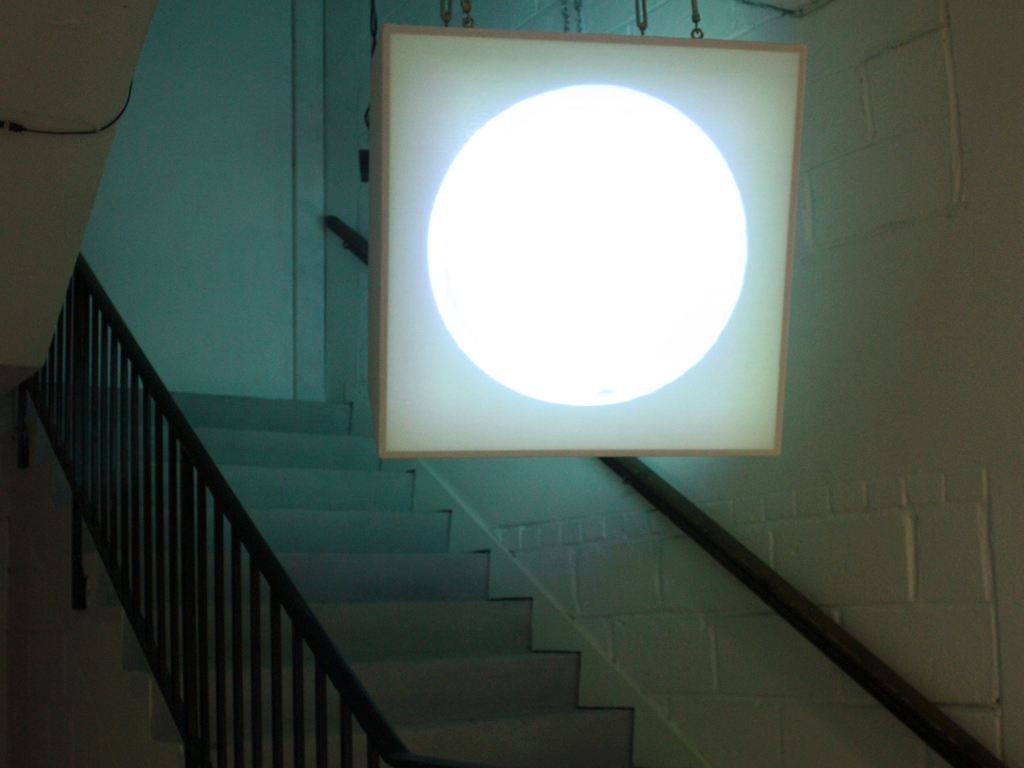Sound Art Exhibition and Events Programme
Curated in collaboration with Kathrine Sandys.
St.James's Hatcham, London (20 — 27 September 2012).
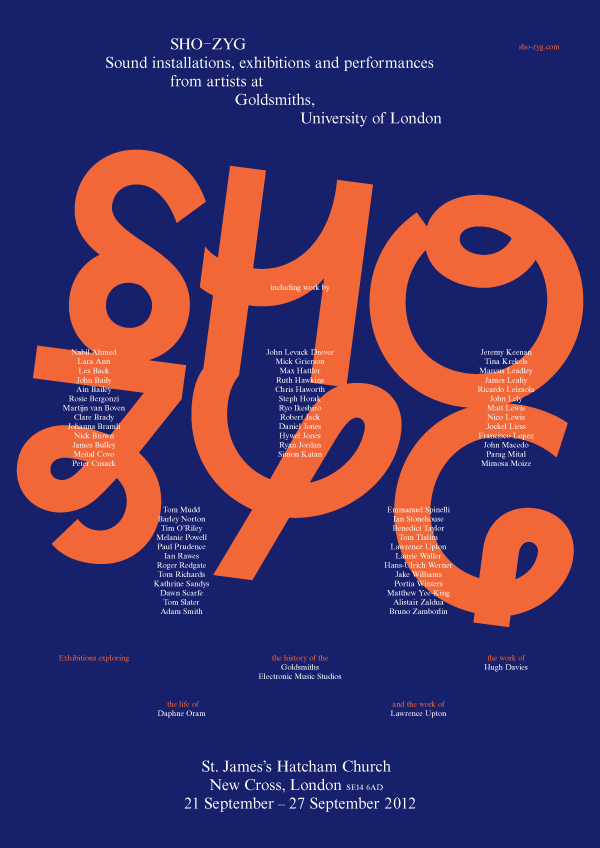
Sho-Zyg 2012 Poster. Design: Joe Hales.
A Sound Walk through the Sho-Zyg Exhibition
St.James's Hatcham Church, New Cross, London, 27 September 2012
[16'38"]
[i] Entrance Hall
[ii] Visiting Hugh Davies (extract from film)
[iii] Private Dreams and Public Nightmares (extract from BBC radio broadcast, produced by Daphne Oram)
[iv] Unmanned Disklavier Programme (extract from Conlon Nancarrow's Study No.21 Canon X. Arranged & recorded by Dominic Murcott & Leo Grant, after a concept by Carlos Sandoval
[v] Technotronic (Sound Installation) - Tom Richards
[vi] Call & Response Programme (extract)
[vii] New Build (Sound Installation) - Jake Williams and Ben Lyford
[viii] Through the Listening Glasses (extract) - Dawn Scarfe
[ix] Audiovisual Programme (extract from the film Sync by Max Hattler)
[x] Iridescent Self (Sound Installation) - Jockel Liess
[xi] Seminary (extract) - Robert Jack
[xii] Electro+ (Orastie) (extract) - Emmanuel Spinelli
[xiii] Film Programme (extract from the film Amir by John Bailey)
[xiv] Memorial Chimes 1&2 (Sound Installation) - Kathrine Sandys
[xv] Radio Reconstructions (Sound Installation) - Daniel Jones and James Bulley
Click on room numbers to navigate to specific rooms on the map;
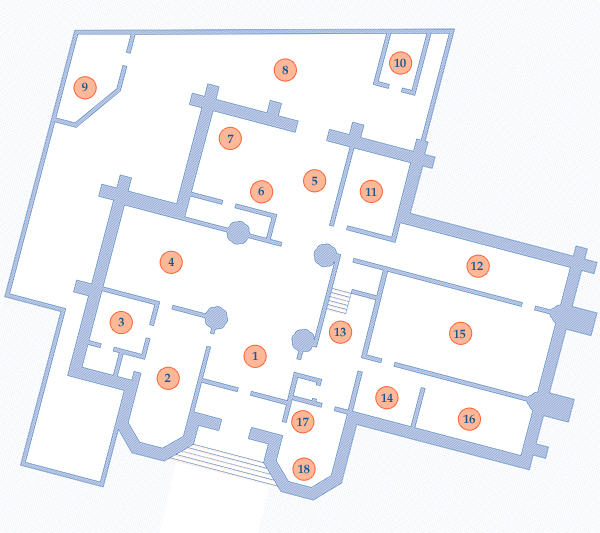
Design: Joe Hales
![]()
Introduction
The Sho-Zyg exhibition takes its name from an improvisatory instrument, the Shozyg, invented by Hugh Davies, founder of Goldsmiths Electronic Music Studios. Davies took the name Shozyg from the final book of an encyclopaedia (from Shoal to Zygote), and it is this anthological notion that we wish to portray within this exhibition. Experimental sound practice and sound art are comparatively new and thriving fields, operating within a historically visually dominated art world. It is our hope that through this showcase we can allow the audience a space to listen: a platform for auditory exploration and new aesthetic experience. |
|
|
Alongside these exhibitions, we were privileged to host From Recent Projects, a solo exhibition by sound and visual artist Lawrence Upton (Honorary Research Fellow at Goldsmiths). The exhibition explored Upton’s current working process, displaying a number of indicative scores, as bases for performance, maquettes, as aids to thought experiments and a silent film arising from his collaboration with the Brazilian plastic artist Wilton Azevedo, as a basis for performance. |
||
Kathrine Sandys & James Bulley, September 2012
Exhibition co-curators;
Ryo Ikeshiro (Audiovisual & Film Programme)
Tom Mudd (Unmanned Disklavier Programme)
Fiorenzo Settimio Palermo (Hugh Davies Exhibition)
Tom Richards (Daphne Oram Exhibition)
Emmanuel Lorien Spinelli (8-Channel Room)
Print Design:
Joe Hales
Web Design:
James Bulley
![]()
Hugh Davies
Curated by Settimio Fiorenzo Palermo
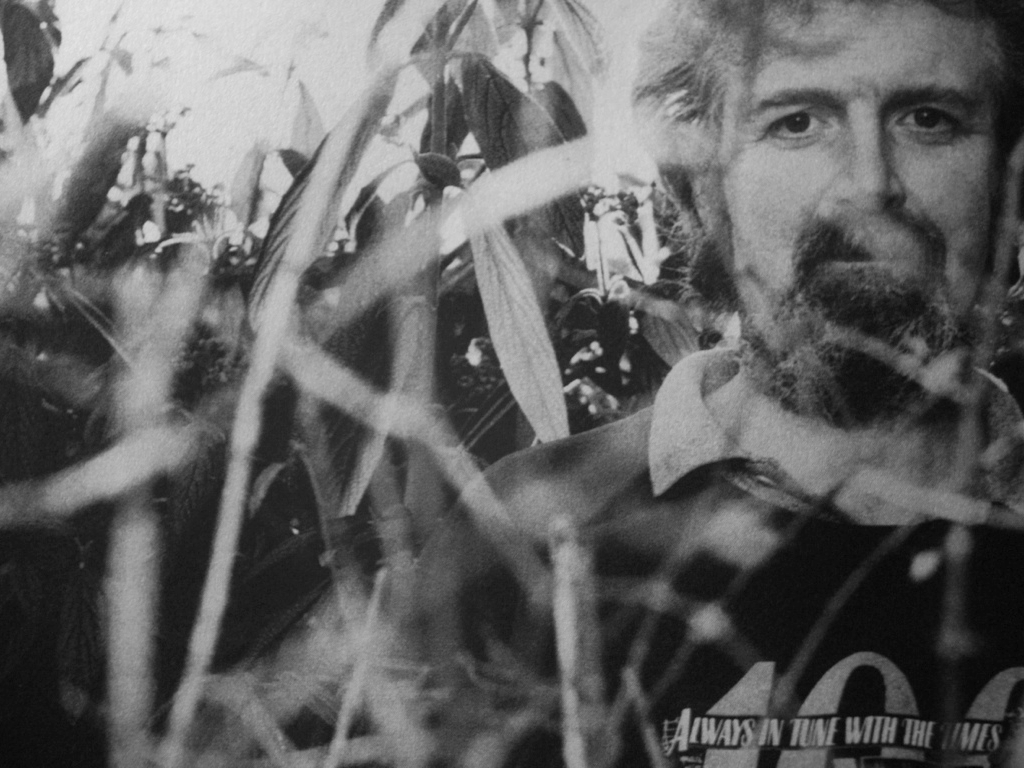 Hugh Davies
Hugh Davies
Photograph: James Bulley
Hugh Davies (1943 — 2005) was a British composer, performer, inventor of musical instruments, sound artist, and musicologist. Davies studied music at Oxford University between 1961 and 1964; he developed an interest in electronic music early: in 1962, he visited Daphne Oram’s Tower Folly studio to further his knowledge on the subject. Davies and Oram quickly established a lifelong professional relationship of mutual support and advice, as demonstrated by the correspondence between them, exhibited here for the first time.
In 1964, shortly after completing his degree at Oxford, Davies travelled to Cologne, Germany, where he worked as Karlheinz Stockhausen’s personal assistant until 1966; this role required dealing mainly with scores: the correspondence with the publishers, their translation, proofs, and corrections.
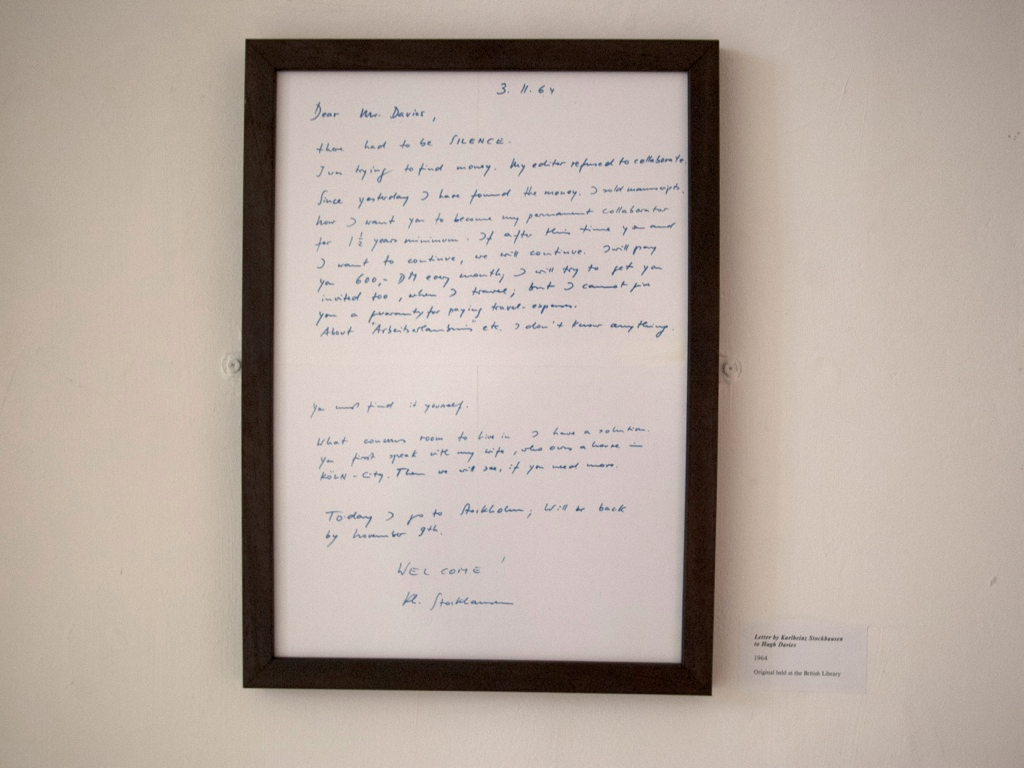
Letter from Karlheinz Stockhausen to Hugh Davies, 1968
Photograph: James Bulley
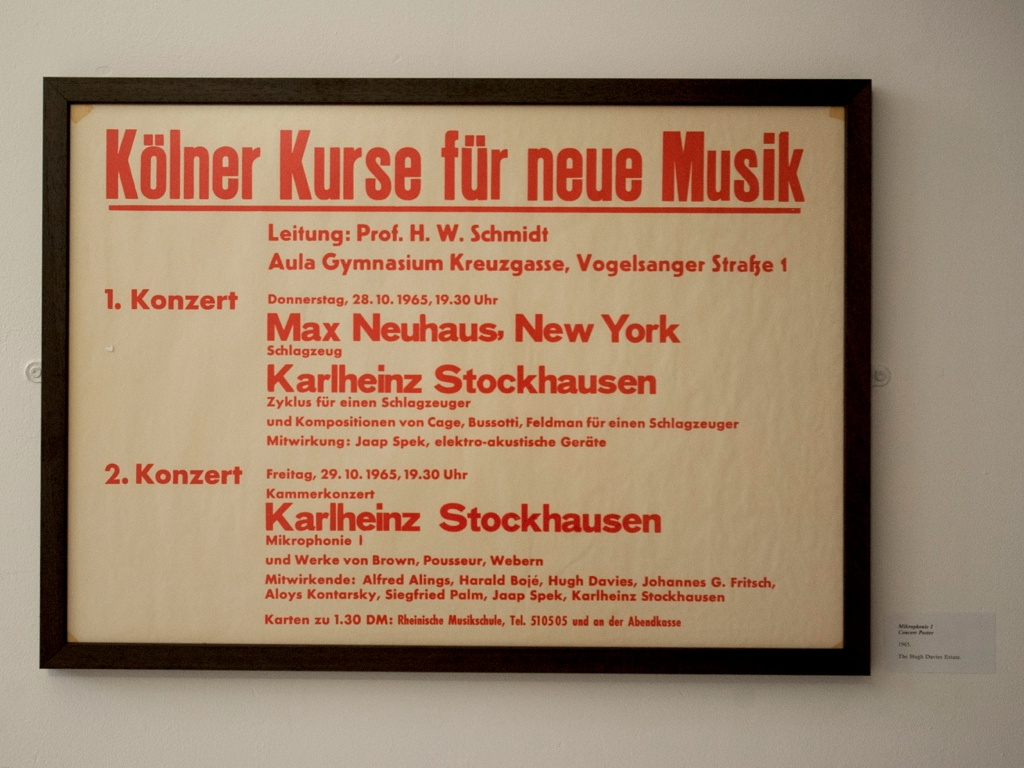
Mikrophonie I Performance Poster, 1965
Photograph: James Bulley
Upon the termination of the engagement with Stockhausen, Davies lived in Paris and New York working on compiling the Répertoire international des musiques électroacoustiques (RIME) or, International Electronic Music Catalog – a survey of electronic music studios, compositions, and techniques published by M.I.T. Press in 1968. On his return to England in 1967, Davies founded the Electronic Music Studio at Goldsmiths College; Davies was the studio director until 1986 and then a consultant researcher until 1991. The EMS was the first facility of its kind at a British institution,and was quickly followed by similar ventures at York University and the Royal College of Music. The initial equipment at the studio consisted of three Revox tapes, a stereo mixer, one air and two contact microphones, a stereo amplifier and loudspeakers, and a sine/square wave generator. Davies ran an Electronic Music Workshop at the studio every Tuesday evening at 7pm from January 1968, to a class of about forty people.
While working as his assistant, Davies participated in the first performances of Stockhausen’s Mikrophonie I (composed in 1964), a live electronic music piece for tam tam, two microphones, and two filters with potentiometer – one of which Davies operated; in this piece disparate, found objects were used to excite the tam tam. The impact of this piece on Davies’s work seems evident when, in 1968, he realised Shozyg I, an invented musical instrument for live electronic performance; the instrument was contained in an encyclopaedia volume; an array of salvaged objects is mounted inside the book cover: a ball-bearing, three fretsaw blades, and two springs; the instrument could be played by striking these objects using finger nails, coins, keys, screwdrivers, etc.
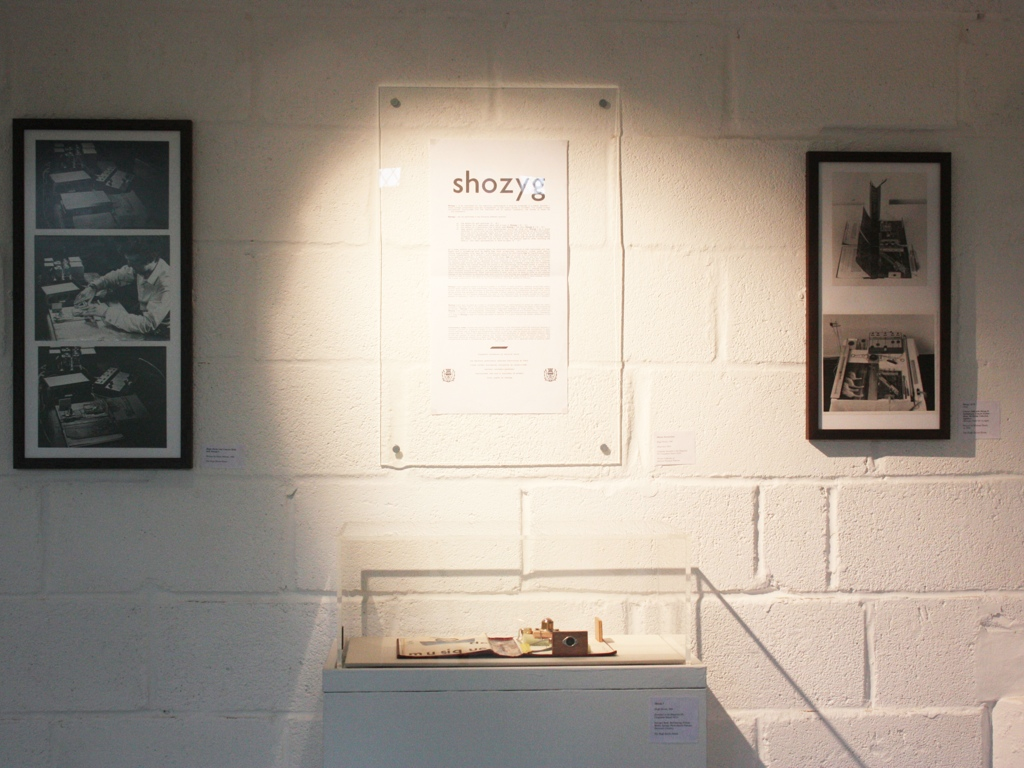
Shozyg I by Hugh Davies
Photograph: Jockel Liess
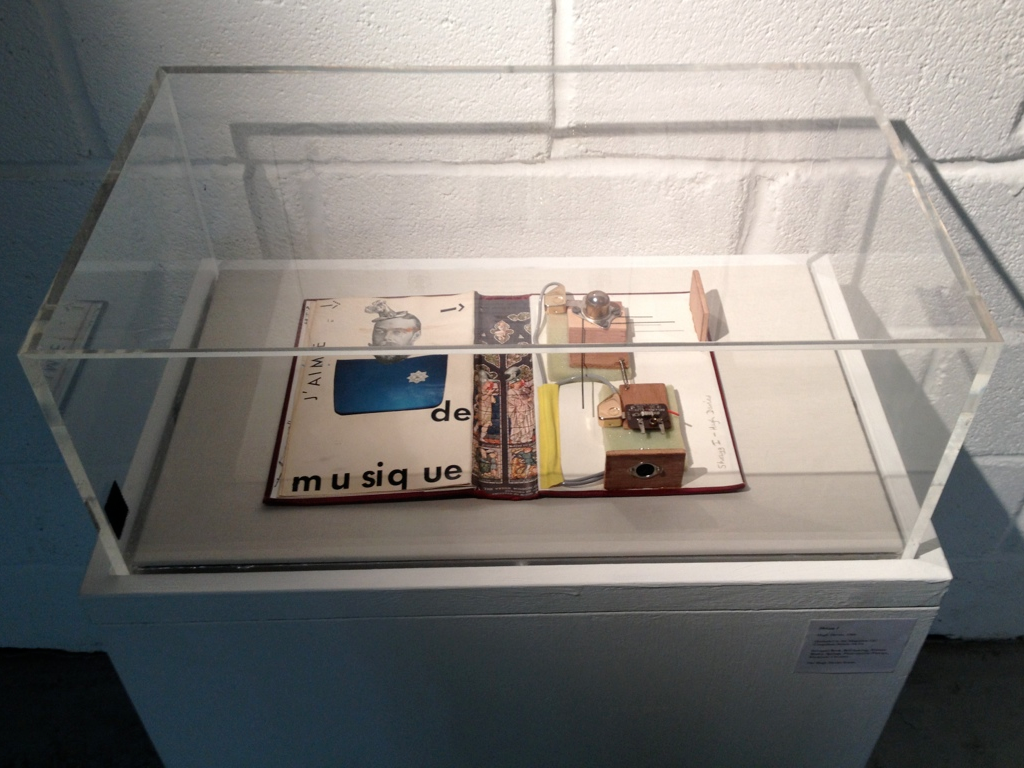
Shozyg I by Hugh Davies
Photograph: Settimio Fiorenzo Palermo
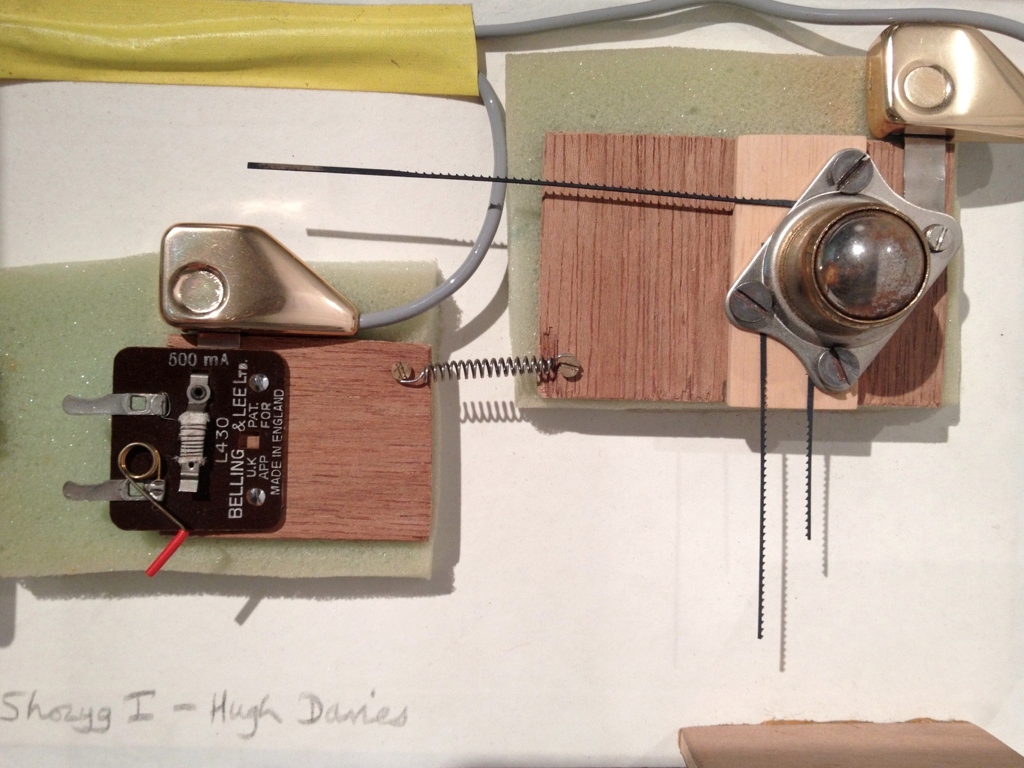
Shozyg I by Hugh Davies
Photograph: Settimio Fiorenzo Palermo
The name ‘Shozyg’ derives from the book cover, where “SHO-ZYG” indicated the entries included in the tome – from shoal to zygote. There exist many versions of a Shozyg, and Davies later understood the term to refer to all his instruments that were amplified, especially those which featured in unusual containers, such as televisions sets, breadbins, electric toasters, accordion files, etc. Shozyg I was the first of more than two hundred concert instruments and sound sculptures devised by Davies. The Shozyg I on display at this exhibition is a special version that was originally included in an edition of the French poet Henri Chopin’s OU Magazine, which also included instructions on how to use the instrument (also part of this exhibition). The few pages left in the book of this version of the Shozyg feature collages by Chopin, who described this artifact as a livre électronique. Davies also discovered instruments; for instance, the Eargong – first devised by Christopher Woodman – which consists of a grill with three crossbars and a length of string. When the string is brought to one’s ears, wrapped around the index fingers for instance, and the grill is struck, it is possible to have what Davies’s called a “private musical experience”, since only the person holding the Eargong would be able to perceive its sound. The original Eargong along with a poster detailing its use is displayed here.
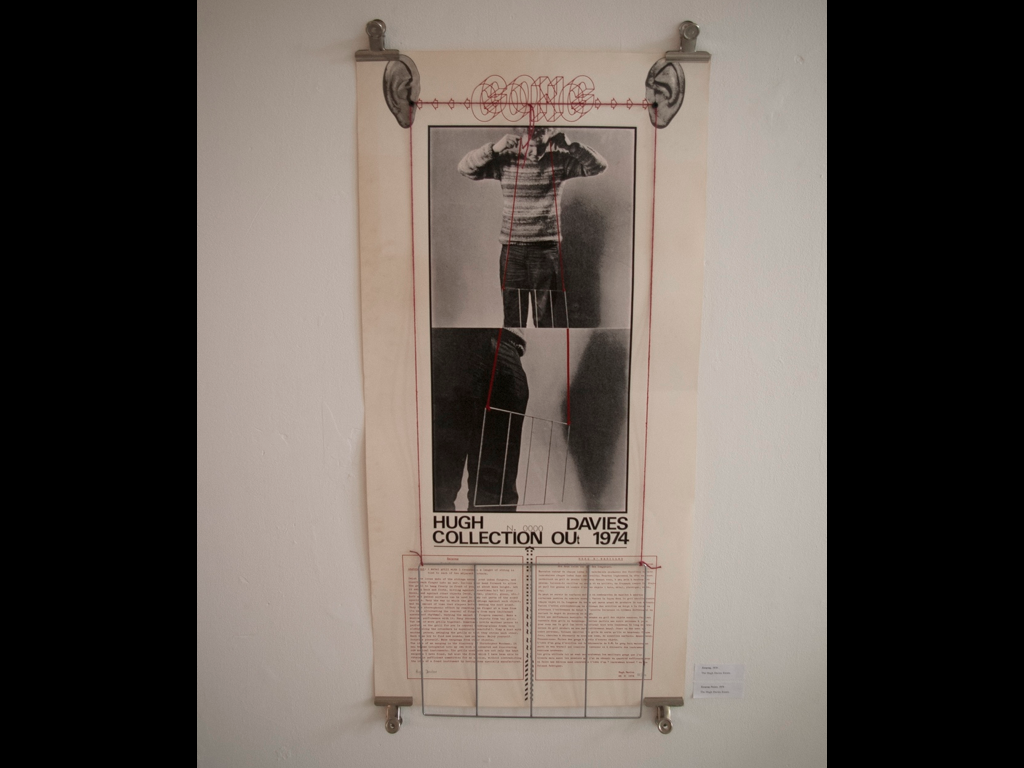
Eargong instrument by Hugh Davies. Poster design by Henri Chopin
Photograph: Havva Basto
Davies often repurposed everyday objects and used them as “found instruments”, similarly to Duchamp’s readymades: an example is the Eggslicer; Davies played this instrument by using its “strings” to produce sounds, and altering their pitch by holding the sides of the egg slicer to alter the tension. A piece called Salad, performed with egg slicers, tomato slicers, and cheese cutters will be regularly playing in the room, as well as a piece featuring improvisations on Shozyg I and Shozyg II by Hugh Davies and Richard Orton. Two other tracks are also played here: an electroacoustic version of a solo performance on Shozyg I by Davies, never released before, and Spring Song, a piece composed using members of the Springboard family. The Springboards consist of springs variously stretched across blockboards of different shapes, and amplified by magnetic pickups. Springs were indeed the most recurrent sound source in Davies’s invented instruments, as he believed that they possessed great acoustic potential and had been unjustly neglected by the orchestral instrumentarium. Three members of the Springboard family and one prototype are on show here at Sho-Zyg, and constitute the focal point of the exhibition.
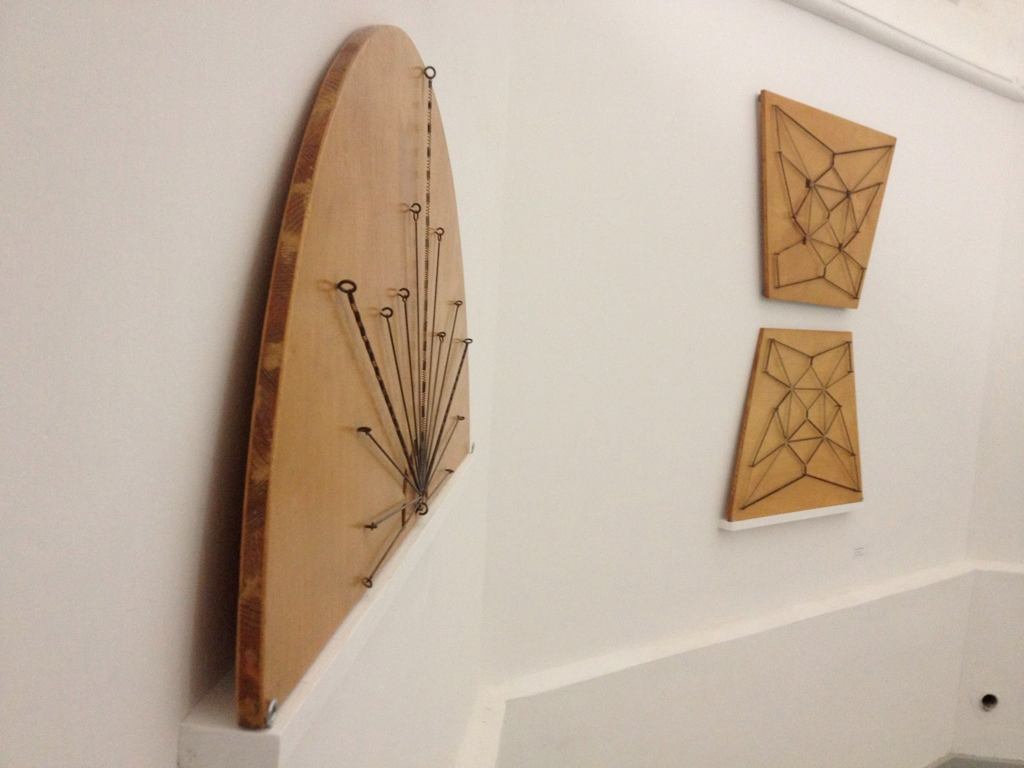
Springboards by Hugh Davies
Photograph: Settimio Fiorenzo Palermo
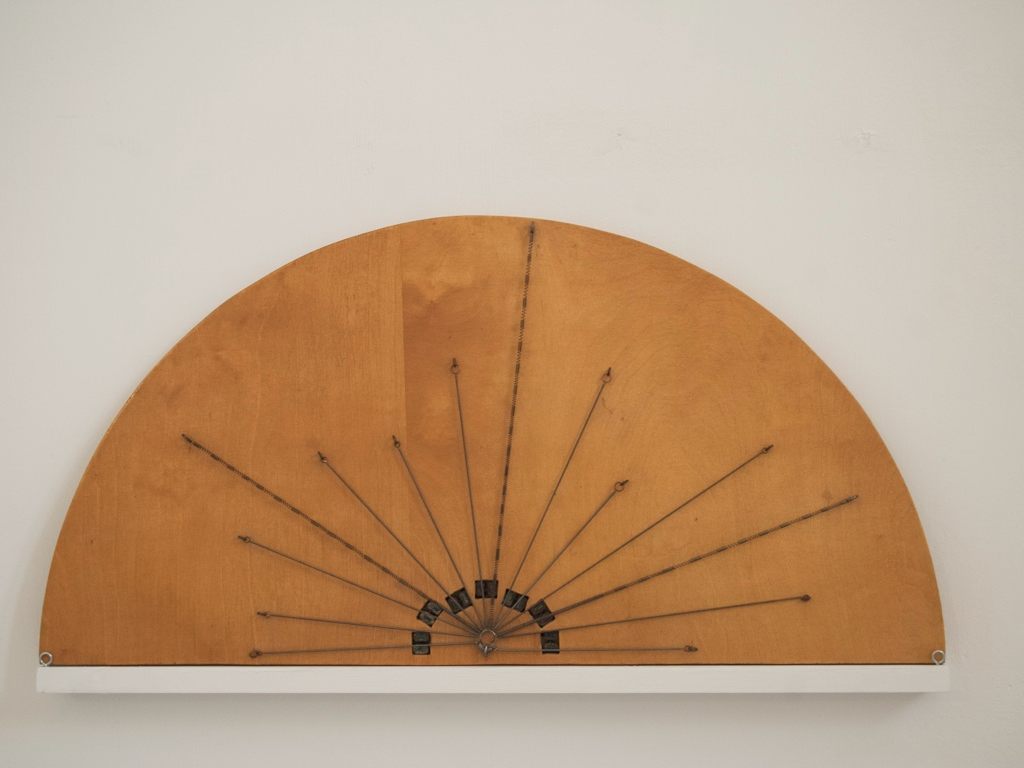
Springboards by Hugh Davies
Photograph: James Bulley
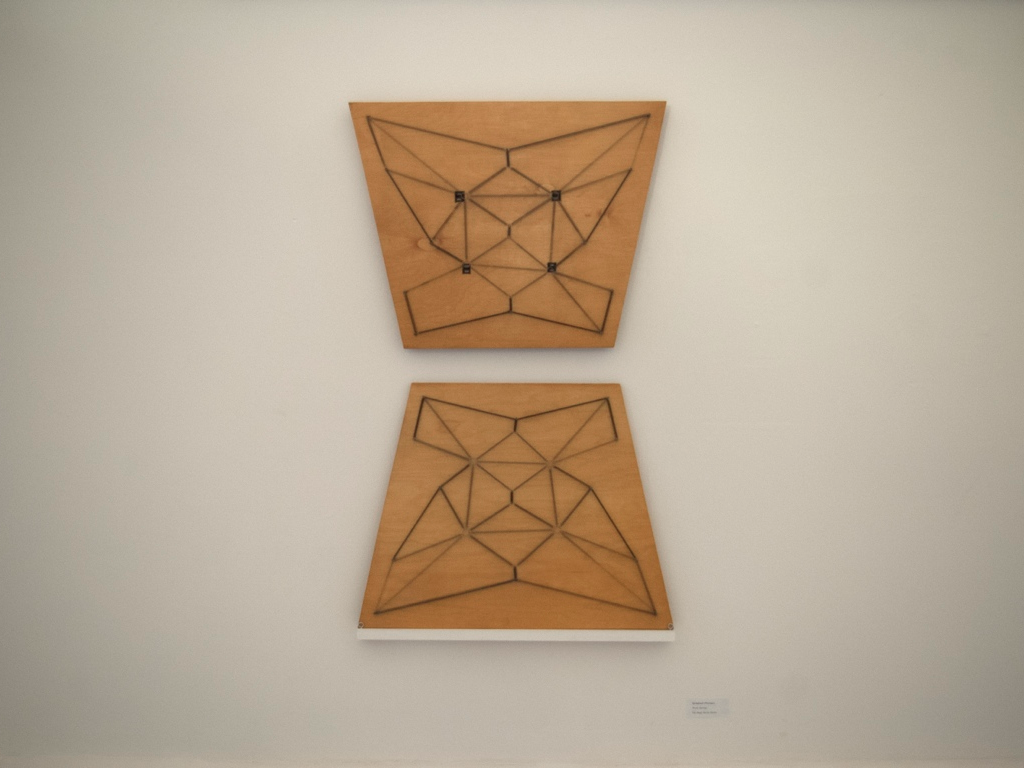
Springboards by Hugh Davies
Photograph: Havva Basto
It is estimated that Davies gave around 200 solo concerts and lecture-recitals on his instruments, and collaborated with dancers, poets and actors, in addition to solo and ensemble performances of composed and improvised music. Davies collaborated with musicians of different musical backgrounds; among others, he was part of the new music ensemble Gentle Fire between 1968 and 1975, a group that developed their own method of collective composition; the Music Improvisation Company with Derek Bailey; from 1969 to 1972; Naked Software with Annea Lockwood, from 1971 to 1973. A series of posters of live concerts given in the early 1970s with these outfits at the Arnolfini gallery in Bristol are exhibited here, proving the versatility of Davies’s musical inventions as performance instruments and his openness towards finding different contexts for them.
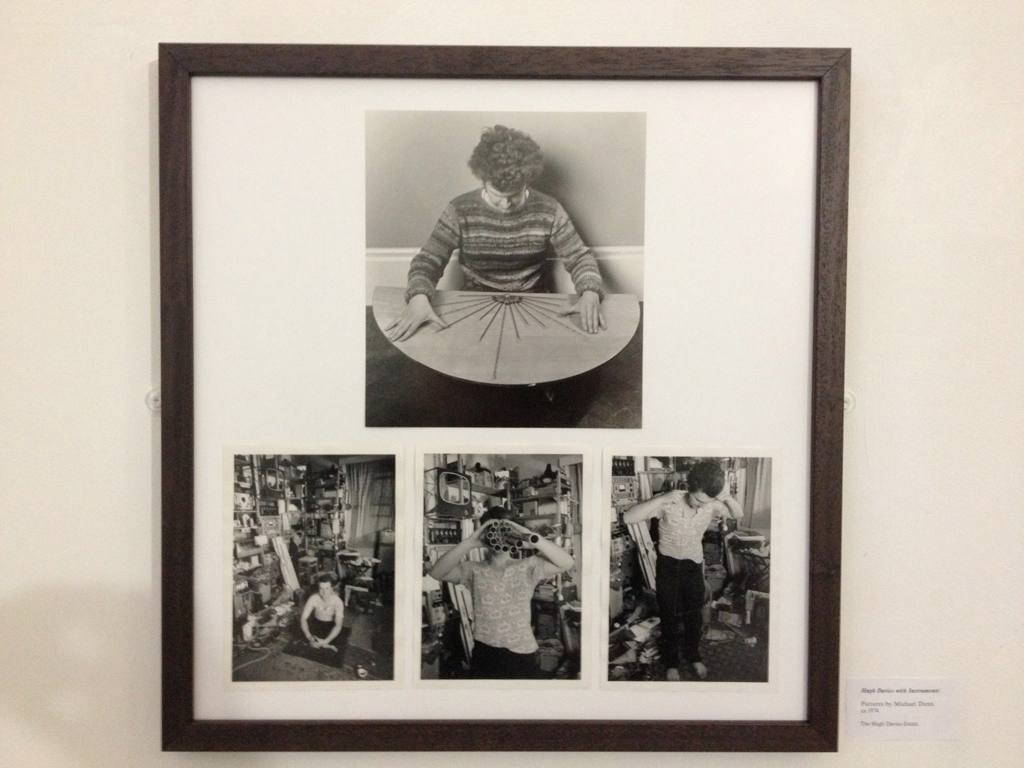
Hugh Davies and Instruments
Photograph: Settimio Fiorenzo Palermo
The Hugh Davies Estate has generously contributed the instruments, photographs, and posters on display at this exhibition. The recordings used are part of the Hugh Davies Collection, held at the Sound and Moving Image Archive at the British Library, and consisting of 282 tapes, cassettes, and CDs storing recordings by and of Hugh Davies. The original correspondence on show here is part of the Hugh Davies archive at the British Library. The video “Visiting Hugh Davies” screening in the room was provided by the Science Museum; the museum also has on permanent display the original Shozyg I and the Eggslicer.
Settimio Fiorenzo Palermo, 2012
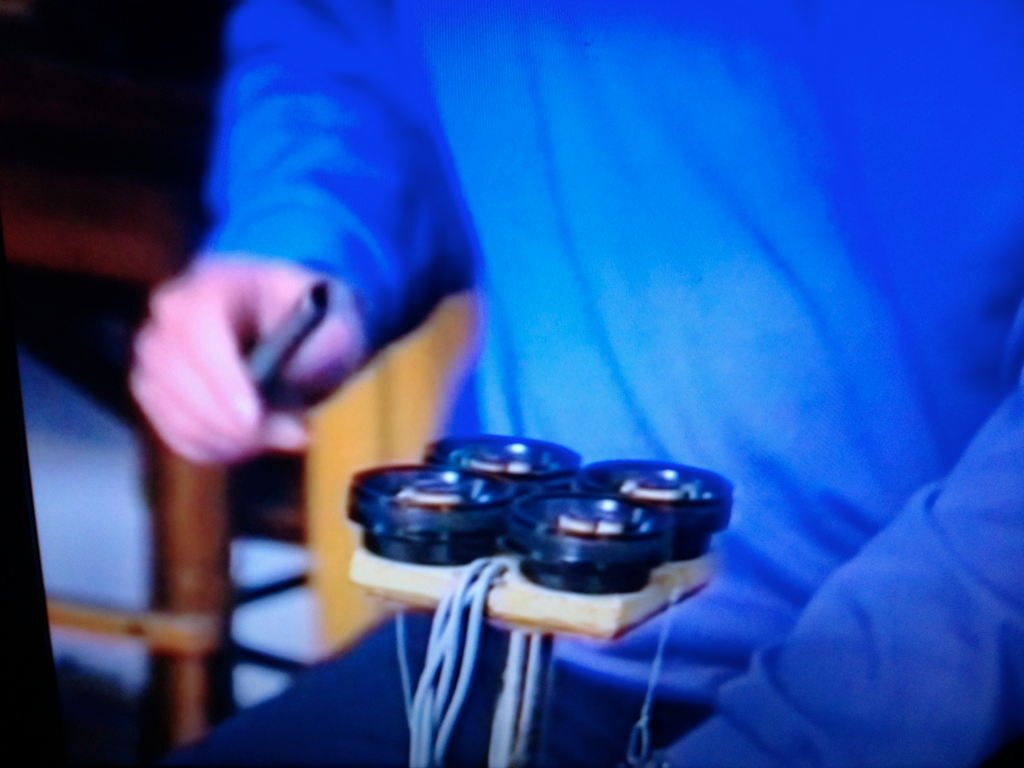 Still from 'Visiting Hugh Davies'.
Still from 'Visiting Hugh Davies'.
Photograph: Settimino Fiorenzo Palermo
The Hugh Davies exhibition at Sho-Zyg 2012 was curated by Settimio Fiorenzo Palermo, a former student of Davies who has recently finished writing a PhD thesis on his work.
![]()
Daphne Oram
'Private Dreams and Public Nightmares'
Curated by Tom Richards and James Bulley
Daphne Oram (1925—2003) was a British composer, inventor and electronic musician. She created the Oramics Machine; a combined synthesizer and sequencer, which used drawn graphics to create and control electronic sound. She was the first composer to be commissioned to provide electronic music for the BBC, producing the soundtrack to the experimental TV drama Amphitryon 38 in 1957. In 1958 she co-founded the BBC Radiophonic Workshop, becoming its first director, and an indelible influence on the work produced throughout its history.
After she left the BBC in 1959, Oram created her own studio at Tower Folly - her house in Kent, where she worked for the rest of her life. She produced a wide range of vital and exploratory works both live and in the studio, with a diverse output: concert pieces, film soundtracks, advertisements and sound for sculpture.
Alongside her studio work, Oram was a researcher with an avid interest in the science and philosophy of sound. She wrote a number of research papers, and gave numerous illustrated lectures at universities, theatres and clubs around the UK. Her book An Individual Note, of Music, Sound and Electronics (1972) provides a fascinating insight into her perspective on sound.
After her death in 2003, composer and electronic musician Hugh Davies inherited her collected works and personal archives. After Davies’ death in 2005, the collection moved via the Sonic Arts Network (now Sound and Music) to Special Collections at Goldsmiths, where it is being accessioned and digitised.The Oramics Machine was recently purchased by the Science Museum, and is currently on display in the ‘Oramics to Electronica’ exhibition.
This exhibition, which takes its title from the 1957 BBC Radiophonic experiment, could just as appropriately be entitled ‘Public Dreams and Private Nightmares’. The selected documents chronicle Oram’s definitive public performances, and also illustrate some of her technical, aesthetic and interpersonal trials and tribulations; how she evaluated competitors, dealt with technical problems and kept her research going with an unpredictable and modest income.
The exhibition is not intended to be a summation of her life and achievements, but rather to be an illustration of the critical environment in which she worked and her response to her contemporaries in the field; especially during her mid career from the late 50s to the late 60s.
Perhaps for the first time we see Oram’s version of events with regard to the history of the BBC Radiophonic Workshop, as well as some fascinating correspondence and notes detailing her position on electronic and experimental music in the context of the computer – her disdain for ‘music by the yard’ and her hopes to infinitely ‘extend the composer’s arm’ with the Oramics system (see letter to Douglas Lilburn in the slide display).
Tom Richards and James Bulley, 2012
Thanks to:
Mick Grierson
Jacqueline Cooke
Daphne Oram Trust
The Science Museum
Goldsmiths Special Collections
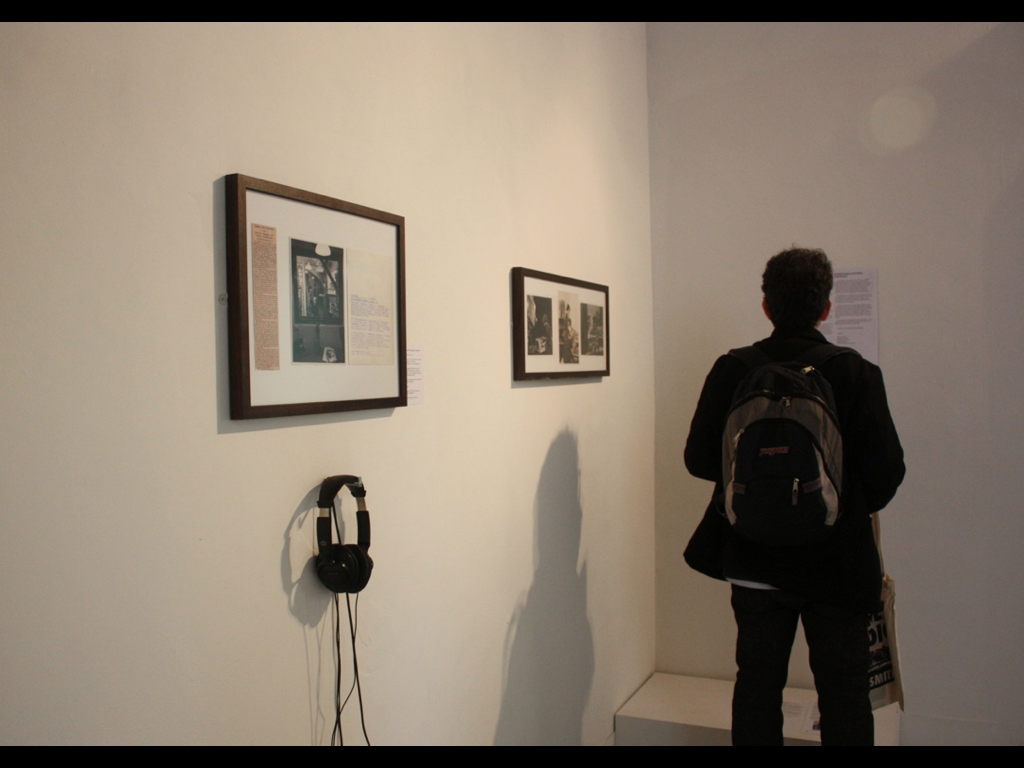
Photograph: James Bulley
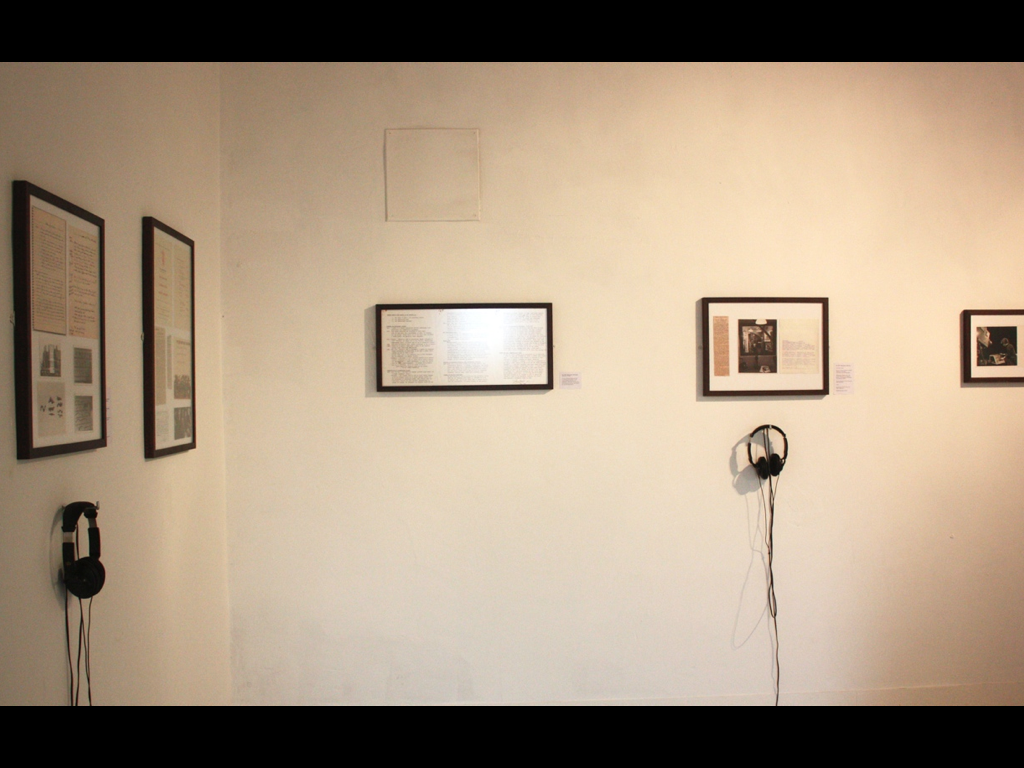
Photograph: Jockel Liess
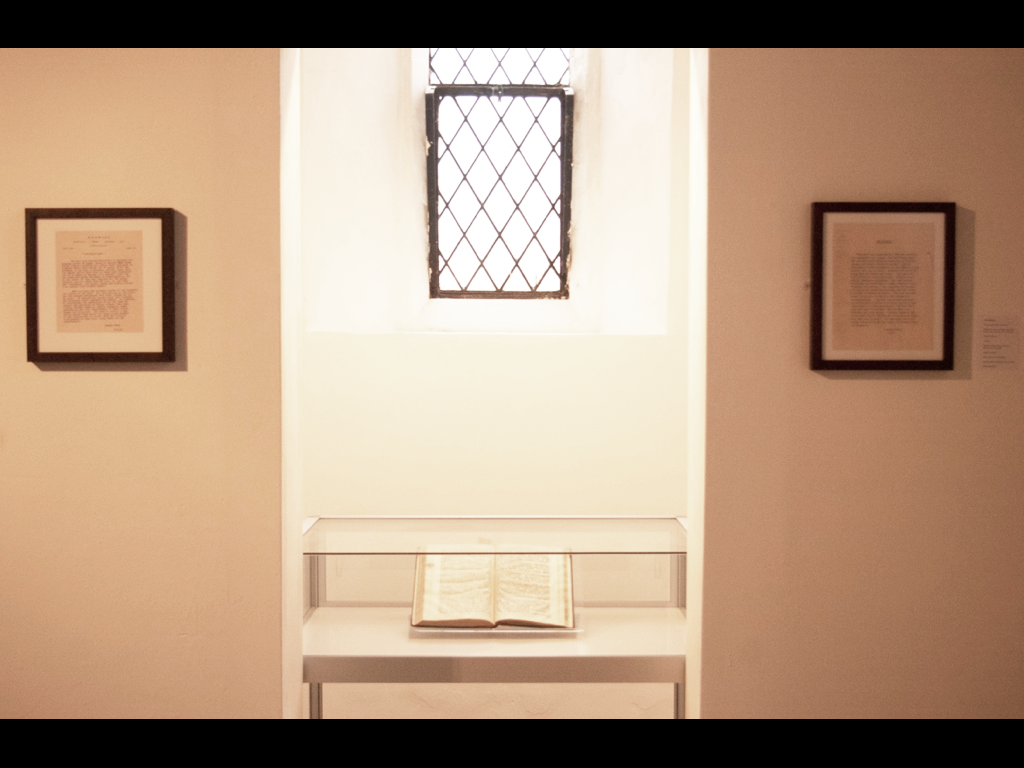 Photograph: James Bulley
Photograph: James Bulley
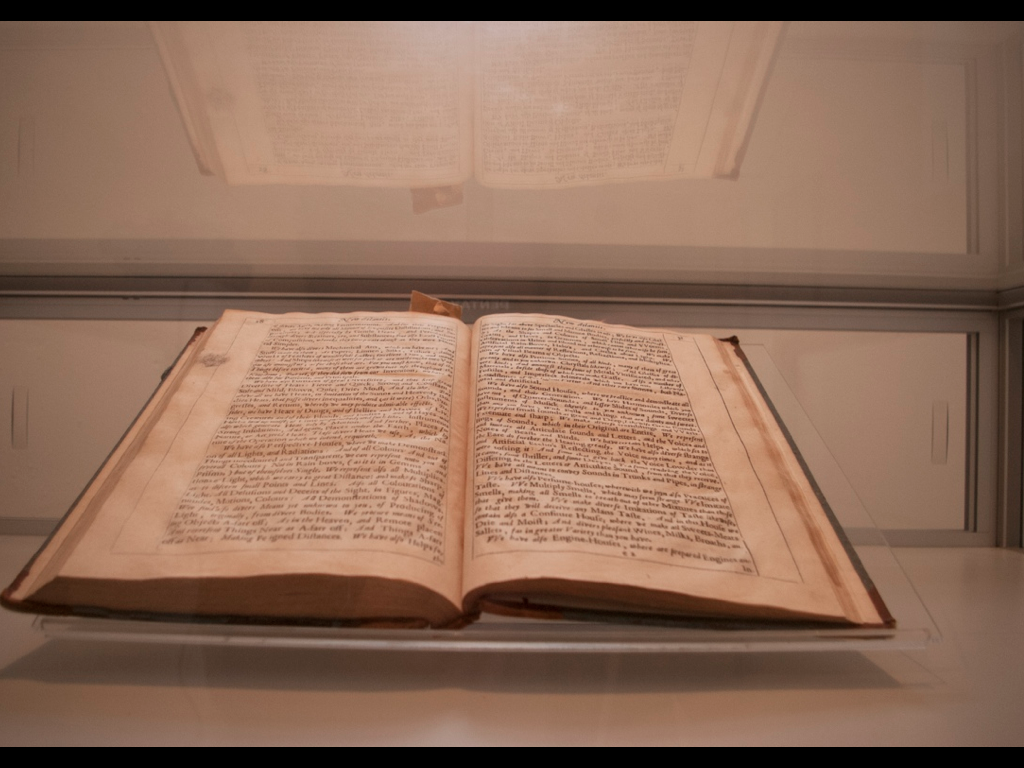
Photograph: James Bulley
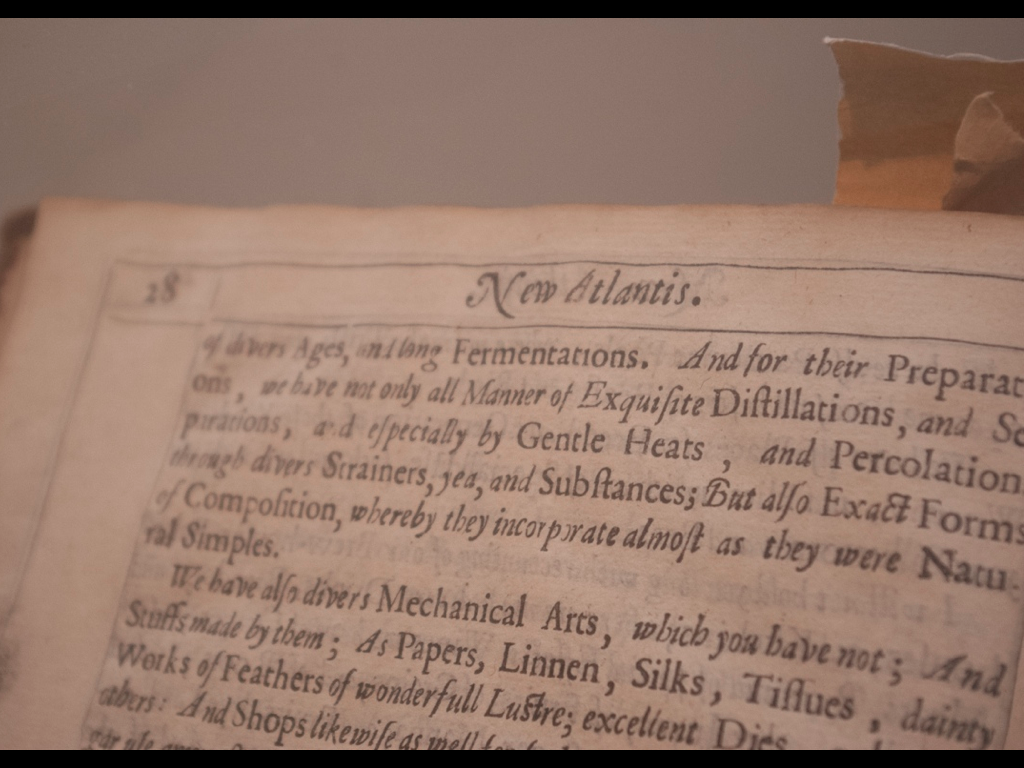
Photograph: James Bulley
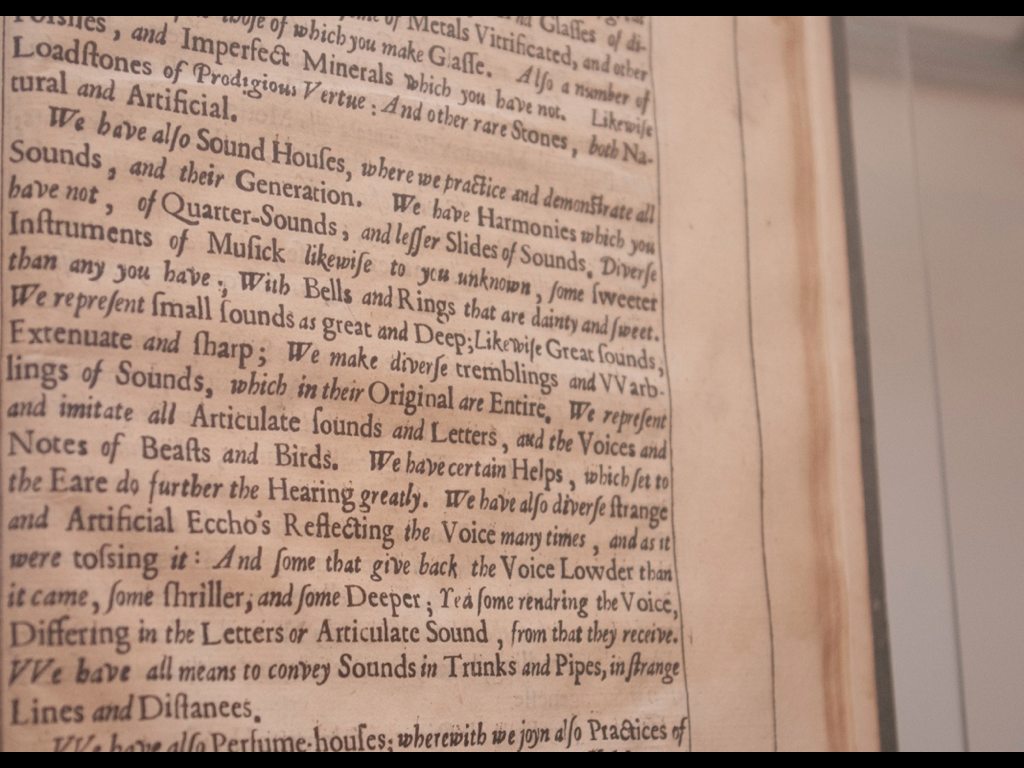
Photograph: James Bulley
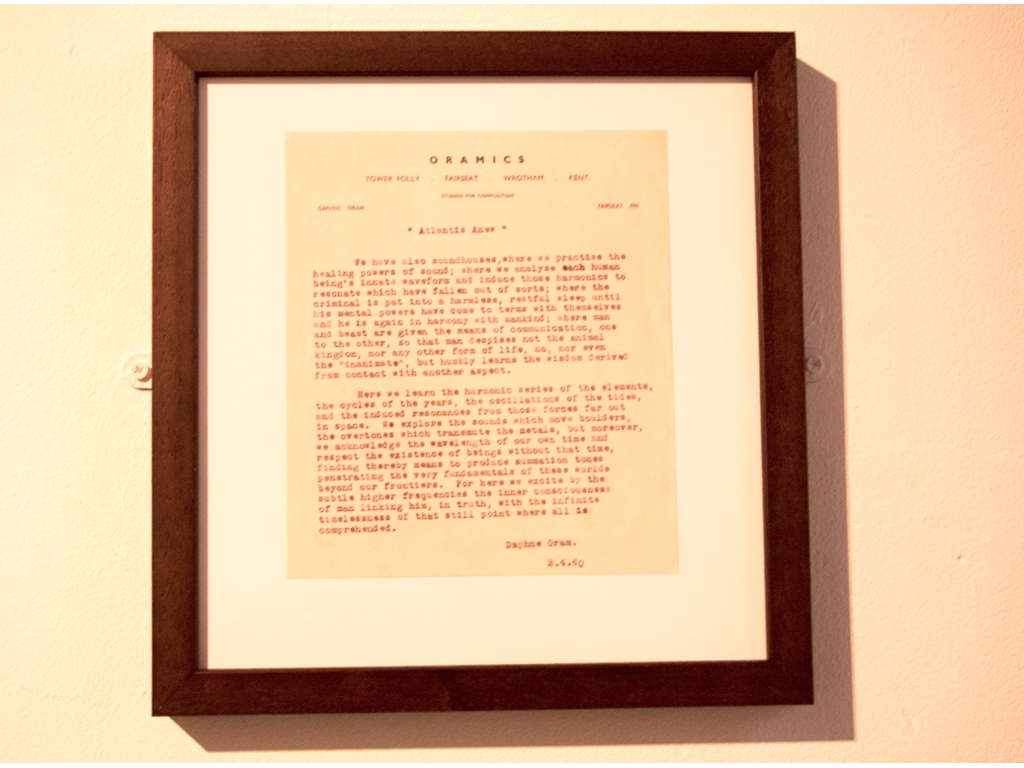
Photograph: James Bulley
![]()
Unmanned Disklavier Programme
Thursday 20 September
7 - 7:30pm
Daily, 21-27 September
11:00 - 11:30
13:00 - 13:35
15:00pm - 15:30 (except Sunday)
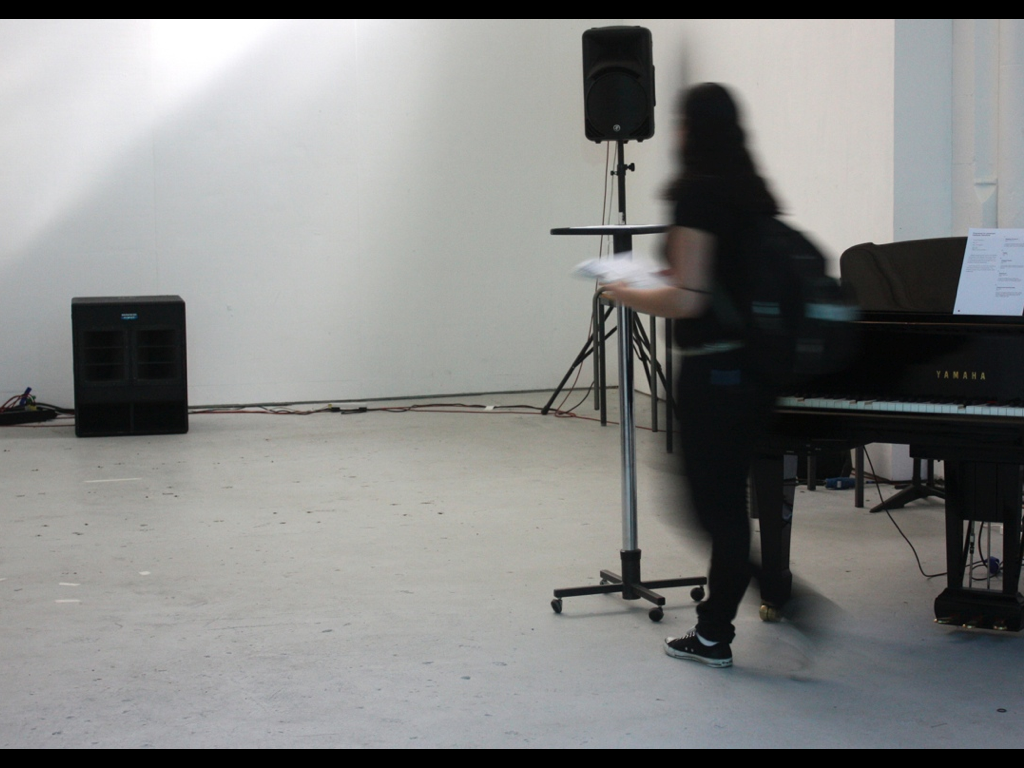
Photograph: Jockel Liess
Self-playing pianos present a mixture of possibilities and limitations to the composer. On one hand, almost unlimited speed and accuracy can be brought to bear on an acoustic instrument, but on the other there is no possibility of performer interpretation.
Conlon Nancarrow was one of the first composers to truly embrace the medium, taking advantage of the rhythmic accuracy to contrast and shift multiple tempos simultaneously.
1.
Study No.21 ‘Canon X’
Conlon Nancarrow
3’30”
Composed sometime between 1965 & 1969.
Arranged & recorded by Dominic Murcott & Leo Grant, after a concept by Carlos Sandoval (2012).
2.
Harlem
Alex Cook
3’30”
3.
Extendor Study 2
Tom Mudd
2’10”
4.
Study No.37
Conlon Nancarrow
10’29”
Composed sometime between 1948 & 1960.
Arranged & recorded by Dominic Murcott & Leo Grant, after a concept by Carlos Sandoval (2012).
5.
Toward a more American Style
Leo Grant
5’09”
![]()
Goldsmiths Electronic Music Studios History
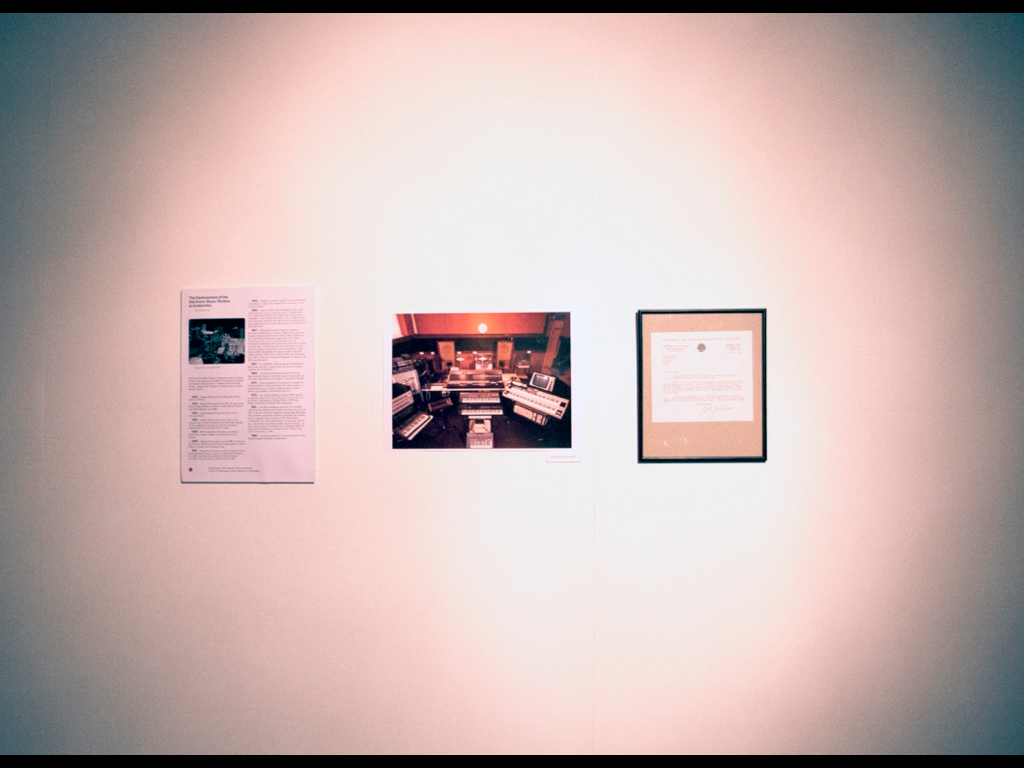 Photograph: Havva Basto
Photograph: Havva Basto
The Electronic Music Studios at Goldsmiths came into being thanks to the inspiration and effort of two pioneers of British experimental electronic music – Daphne Oram and Hugh Davies – alongside the influence of composer and academic Stanley Glasser.
1925 — Daphne Blake Oram born December 31st in Devizes, Wiltshire.
1942 — Daphne Oram declines the offer of a place at the Royal College of Music to work as a Junior Studio Engineer and ‘Music Balancer’ at the BBC.
1943 — Hugh Seymour Davies born April 23rd in Exmouth, Devon.
1950 — Daphne Oram composes the (still, as yet) unperformed 30-minute orchestral work Still Point, arguably the first composition to utilise the real-time electronic manipulation of pre-recorded and live sound.
1958 — BBC Radiophonic Workshop is founded in Maida Vale, London. Daphne Oram becomes its first director.
1959 — Daphne Oram resigns from the BBC and sets up her Oramics Studios for Electronic Composition at ‘Tower Folly’ in Fairseat, near Wrotham, Kent.
1961 — Hugh Davies attends a lecture of Daphne Oram’s at the Mermaid Theatre, London. He subsequently works in her studio, learning about electronic music and sound recording. They correspond until her death in 2003.
1962 — Daphne is awarded a grant from the Gulbenkian Foundation to support the research of her “Oramics” drawn sound technique.
1966 — Daphne Oram visits Goldsmiths to give a talk about electronic music; a subsequent letter of thanks from J.A. Gulland (then Head of the Adult Studies Department) concluded: “I am not quite sure what we as a College do next about electronic music but you have certainly stimulated very great interest that may, in time, develop into a serious study of the subject here”.
1967 — following two years working as assistant to Karlheinz Stockhausen in Germany, Hugh Davies returns to England. He approaches Stanley Glasser, Head of Music for the Adult Studies Department (later Head of the Music Department), with a view to establishing a studio at Goldsmiths, something which Glasser had been keen on doing for many years. At that time there were fewer than a dozen permanent studios in operation across Great Britain, aside from the BBC Radiophonic Workshop in Maida Vale and Daphne Oram’s ‘Tower Folly’ studio in Kent, and the period from 1967 to 1970 saw a sudden development of studios in the UK university sector.
1967 — by December, initial equipment included three Revox tape recorders, a stereo mixer, one air mic, a stereo amplifier and loudspeakers.
1968 — in January the Electronic Music Workshop begins evening classes in electronic music at Goldsmiths, the first such regular class in an academic institution in Britain.
1976 — studio equipment has expanded to include two VCS3 synthesizers, numerous Revox A77 tape recorders, a custom-made mixer, a range of ring-modulators, phase-shifters, wave-shapers, reverberation units etc.
1979 — the studio purchases a Roland 100M modular synthesizer (still in use today), followed in the next few years by Syntauri alphaSyntauri, Roland SH101, EDP Wasp, Roland Juno-106 and Yamaha DX7 synthesizers.
1981 — the studio purchases one of the first Fairlight CMI series II computer music systems to find its way into the UK, at the time extremely expensive, cutting-edge technology. This attracted a great deal of interest, including new students such as composer Adrian Sutton (of War Horse fame) - “Goldsmiths was a very special place to study music, and for me it was the Electronic Music Studio that attracted me... It was precisely because Goldsmiths had a Fairlight CMI in its studio that Goldsmiths was the only choice I stated on my UCCA form back in 1986!”
1985 — the studio relocates to its current location in the Richard Hoggart Building in Goldsmiths.
Ian Stonehouse, 2012
![]()
Technotronic - Tom Richards
Pre fabricated case with hand made analogue and digital electronics. 100x350x180mm
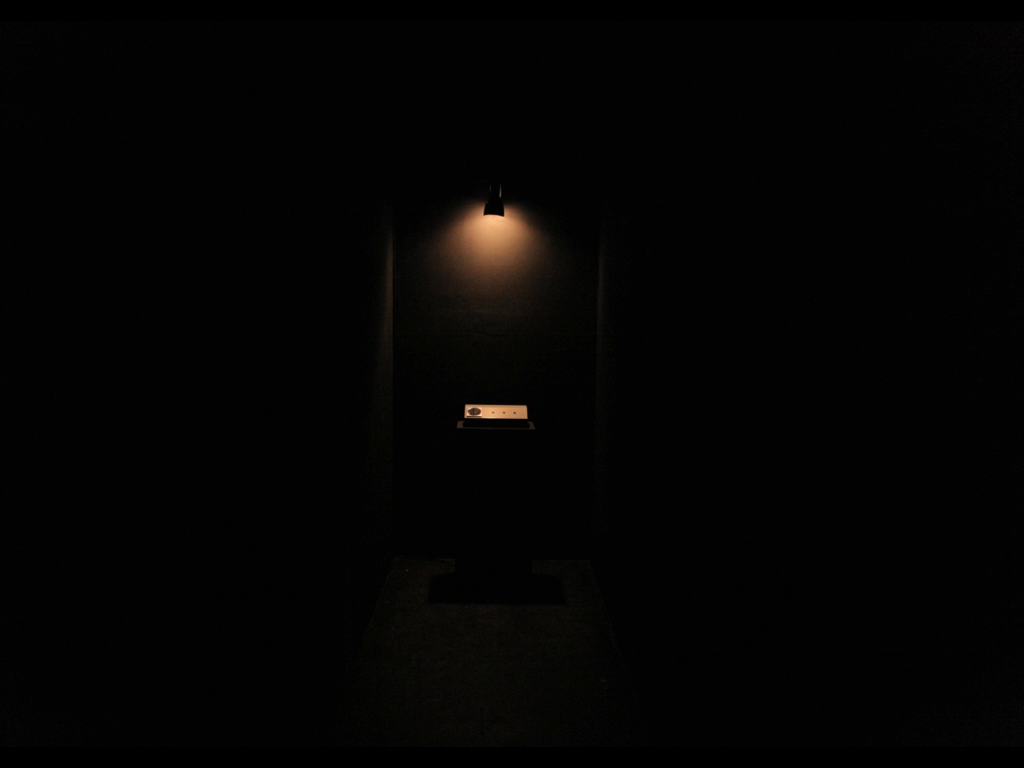
Photograph: William Pine
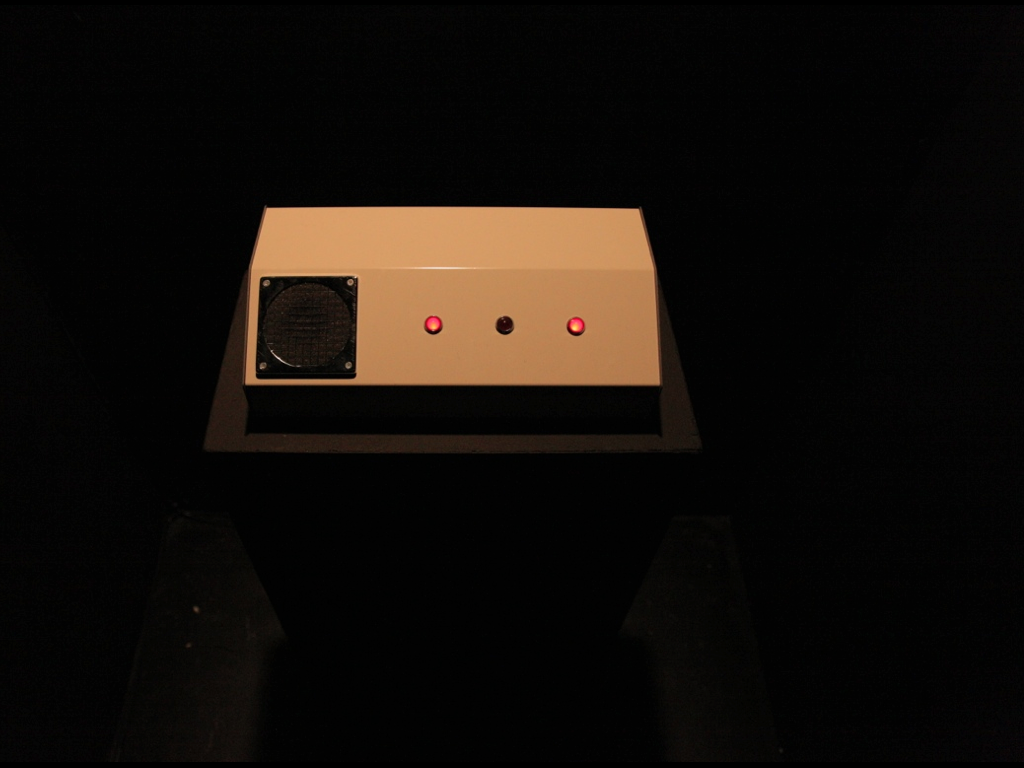
Photograph: William Pine
![]()
Listening Posts
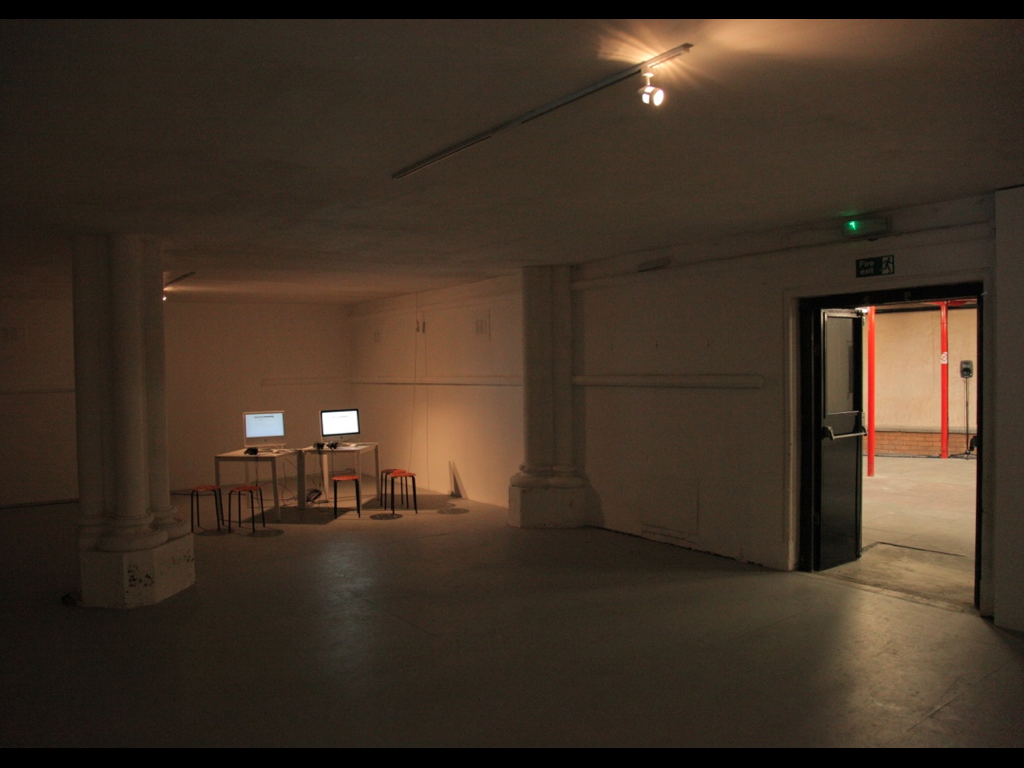 Photograph: William Pine
Photograph: William Pine
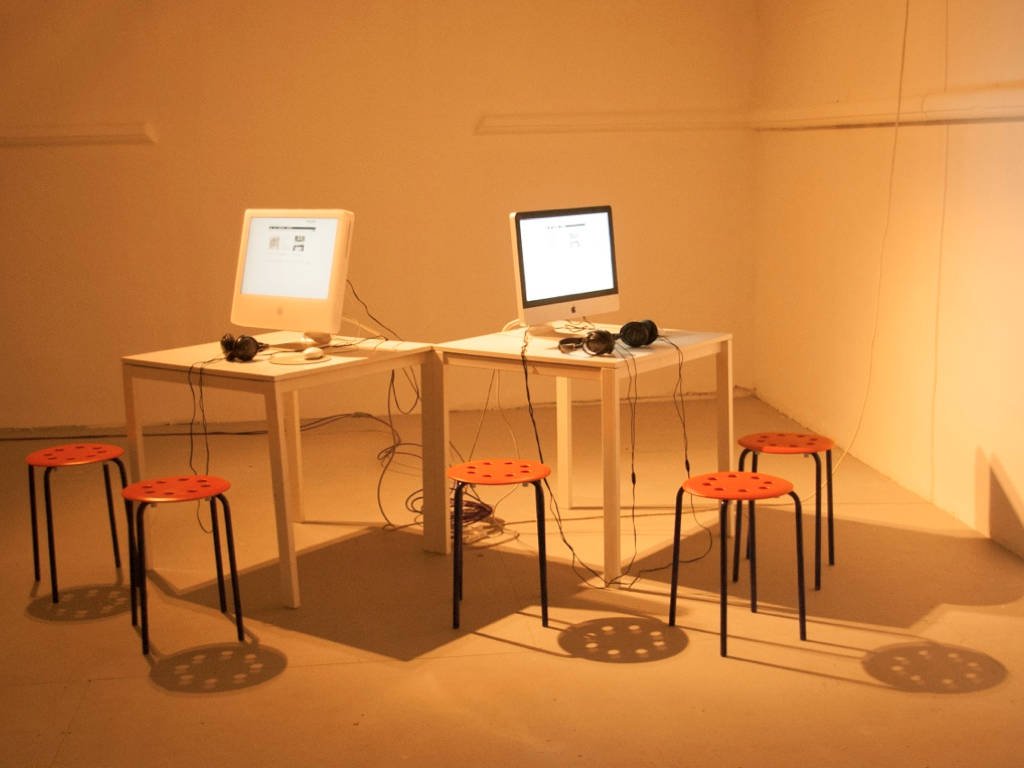 Photograph: Havva Basto
Photograph: Havva Basto
Goldsmiths Music Archives - http://eprints-godo.gold.ac.uk/view/divisions/mus/
![]()
Call & Response
Call & Response are a London-based sonic collective and curatorial platform for multi-channel sound art and other audio-based works in an immersive environment.
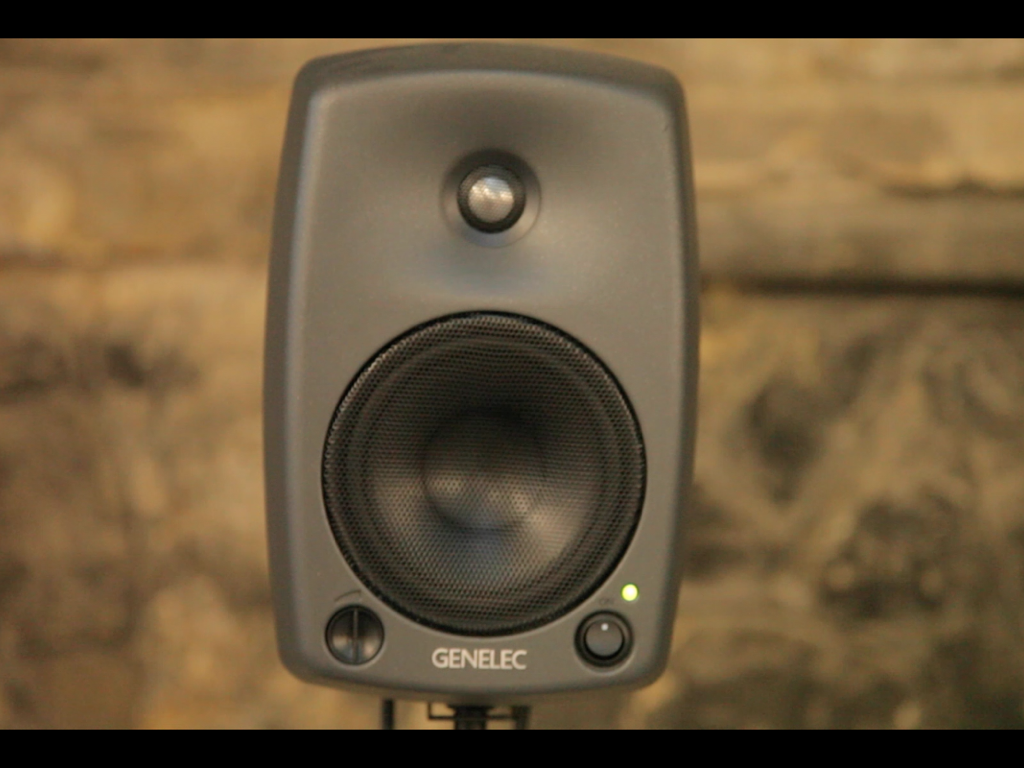 Photograph: William Pine
Photograph: William Pine
Angel
Jo Thomas
18’43”
‘Angel’ is an exploration of sound questioning the passing of time. The human body and the imagination are referenced closely together throughout this work as a means of exploring strange imaginary landscapes, fantasies of flight, timelessness and the human condition.
North Sea Crossing
18’22”
Jeremy Keenan
A piece based on recordings made crossing the North Sea by ferry in 2009. Waves, engines, birds, voices, all processed by various degrees to form the composition. Sharp contrast is interchanged with slow evolution, the structure of the piece being informed by both the immediate timbre of the sounds, as well as their internal history unfolding over time.
Stranger Part 2
Robert Van Heumen
8’20”
Stranger is conceived as an electronic composition as well as a research in the composition process. Stranger is composed using the family-tree concept. In this concept a tree of sounds is build by iteratively applying a predefined number of processes to a small set of samples.
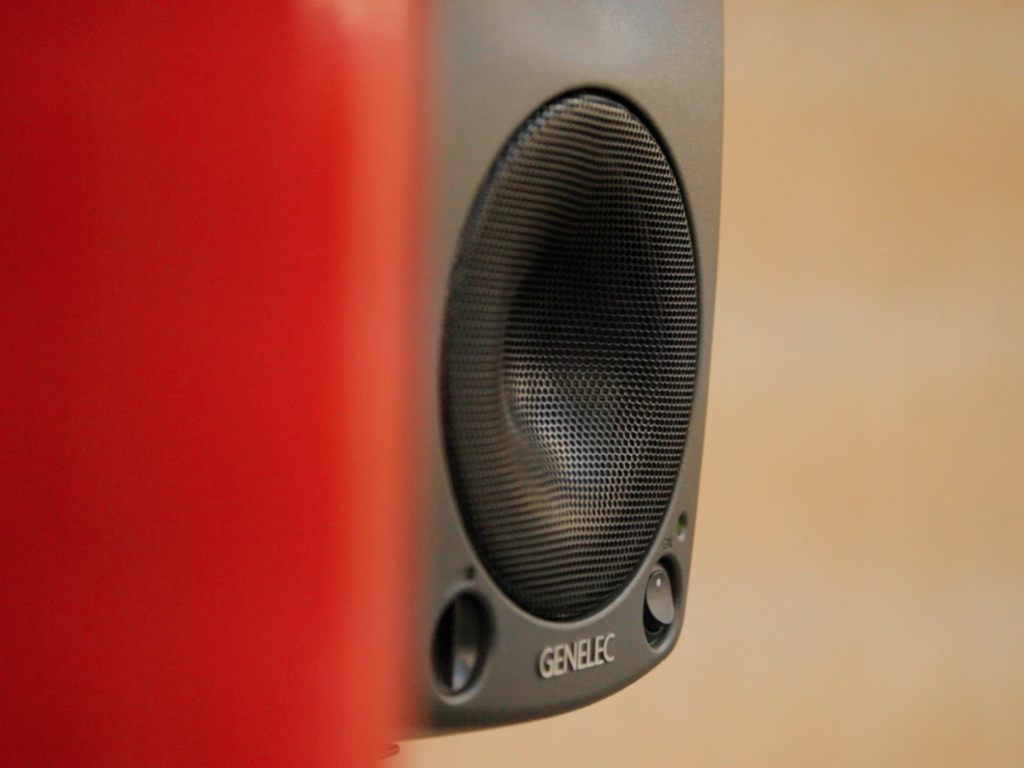 Photograph: William Pine
Photograph: William Pine
Opaque
Steinbrüchel
9’46”
Ralph Steinbrüchel produced the audio sculpture ‘Opaque’ for the Taktlos music festival in Berne in 2003. It was prepared for a very quiet and large listening environment - unlike home listening situations. ‘Opaque’ is a subtle, spatial work consisting of minimal high and low-end frequency synthetic sounds.
Trouble in the Ether
Matt Lewis
9’33”
This piece was developed as generative work for the 12-channel ambisonic system at Diapason Gallery, New York. The work uses recordings of helicopter flights recorded in Sao Paulo, Hampshire and at London Heliport. The original recordings have been heavily filtered and processed with additional pitch material based on flight coordinates.
Eldjfall
Jacob Kirkegaard
15’33”
‘Eldjfall’ consists of field recordings of subtle volcanic vibrations in the earth recorded in the area of Krisuvik, Geysir and Myvatn in Iceland. These very condensed and rhythmical trembling sounds from inside the earth were captured using accelerometers.
She’s Swinging Her Hammer
Freida Abtan
7’42”
Freida Abtan is a Canadian multi-disciplinary artist and composer. Her music falls somewhere in between musique concrete and more modern noise and experimental audio and both genres are influential to her sound.
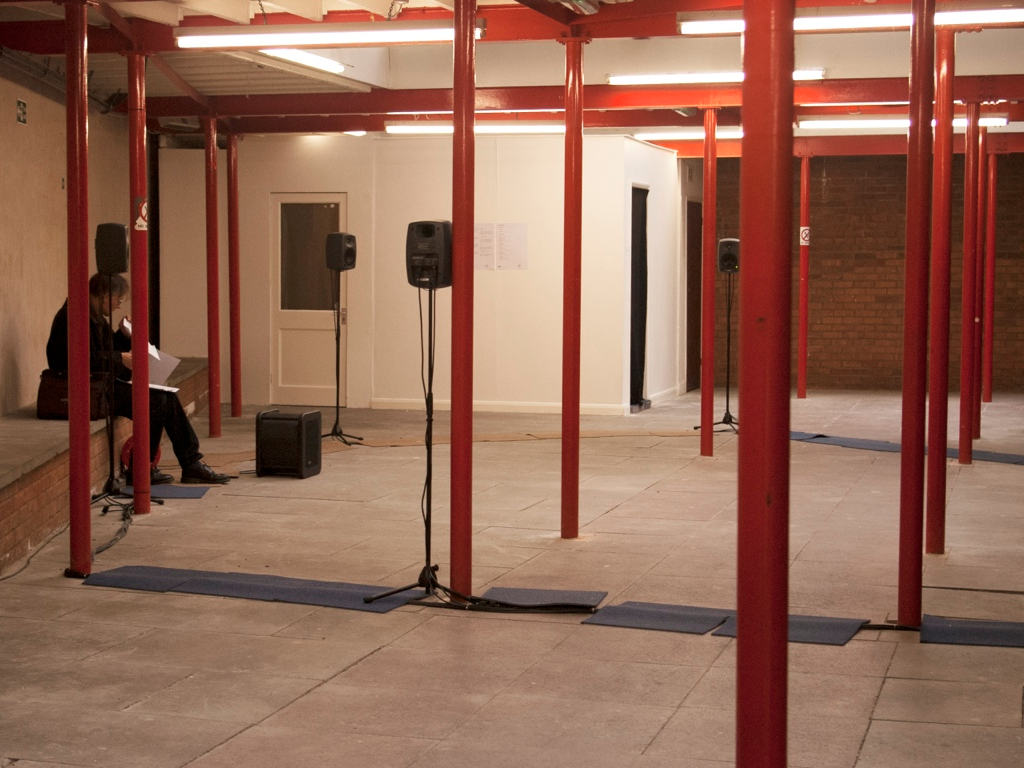 Photograph: William Pine
Photograph: William Pine
http://callandresponse.org.uk/
![]()
New Build - Jake Williams & Ben Lyford
"A new-build showhome flat rebels upon it's occupants"
New Build is inspired in particular by two written works - JG Ballard's novel High Rise (1975) and Laura Oldfield-Ford's art-zine and book, Savage Messiah (2011) - which explore dystopias of gentrification, and the cheap luxury of modern high-rise living environments. In both, a sinister fantasy-project of controlling and perfecting humans through their material possessions and their physical environment unravels with ghastly results.
New Build embodies a haunted utopia. It's monochrome design, clean lines, minimal furnishing and foam-board construction evokes an architectural model or show-home. The sinister relation of spirit to inanimate object is further explored by using the room an instrument - played by a composition of MIDI notes on an eight-minute loop, each having a light as well as a sound response.
This composition was realised in an unusual way: I began with a series of lights, and planned what colours would be where in the room, and whether they would flash or fade. I then composed for these lights, visualising them as I wrote the music / sound design. Each element of the music was then mapped back to its corresponding light so that lights and music triggered at the same time. This kind of compositional feedback loop intends a true synergy between sound and light, in which neither has preceded the other.
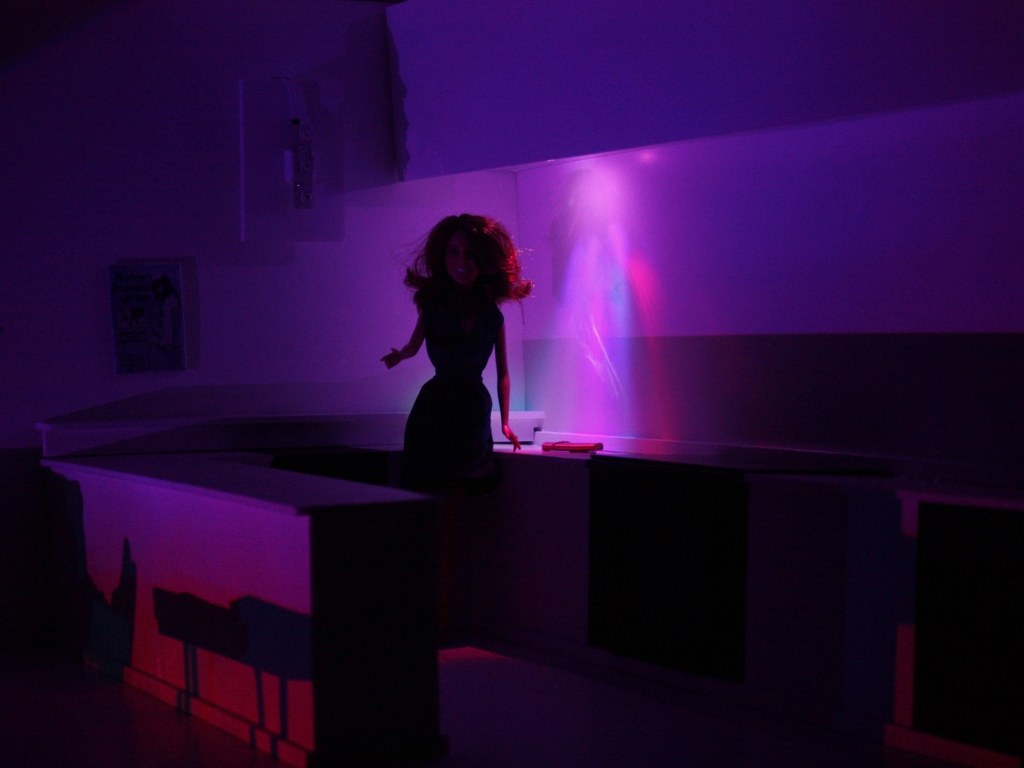 Photograph: Jockel Liess
Photograph: Jockel Liess
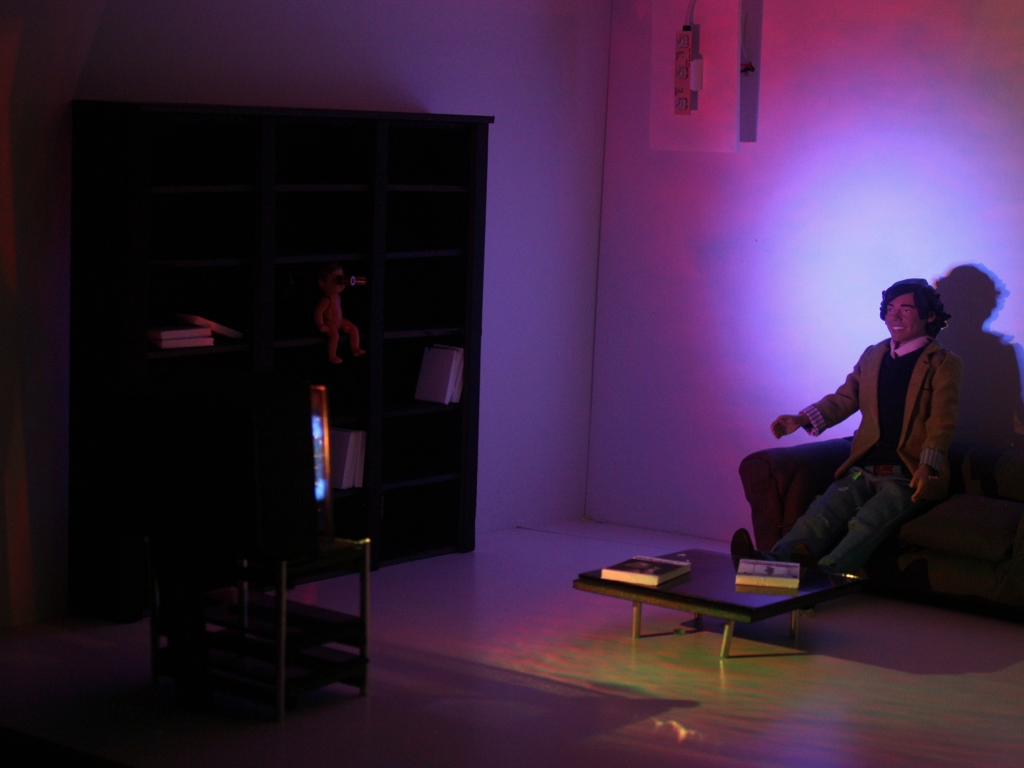 Photograph: Jockel Liess
Photograph: Jockel Liess
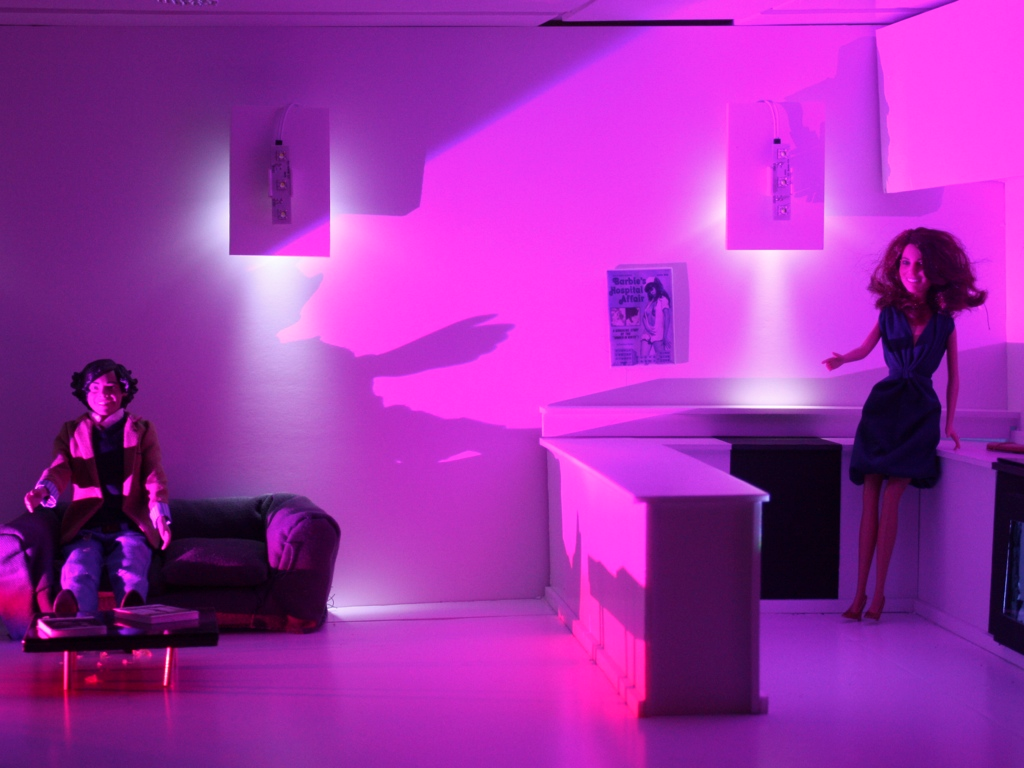 Photograph: Jockel Liess
Photograph: Jockel Liess
![]()
Through The Listening Glasses - Dawn Scarfe
Binaural recording, headphones, desk, chair, lamp and leaflets
2010
This piece was recorded with binaural (in ear) microphones. It documents a walk in search of musical tones in the sound of the environment using a series of tuned spherical glass instruments called ‘Listening Glasses’. The glasses are hollow spheres with a funnel at one side (for insertion into the ear) and an opening at the other which allows sound to enter. Each glass is calibrated to a particular musical tone, and amplifies this tone if it sounded in the surrounding air through a process of ‘sympathetic resonance’. For the recording, the microphones are placed either in the ear or in inside the glass.
This installation forms part of a series of works which explore the act of listening through the ‘lens’ of Listening Glasses. Scientist Herman von Helmholtz (1821-94) developed glass resonators to identify
subtle partial tones in the sound of musical instruments. He confessed to taking them outside of his laboratory and listening for their tones in ‘noises’ such as the rumbling of carriages, the whistling of wind
and the splashing and seething of water. The thought of Helmholtz embarking on these listening excursions inspired me to make a new series of resonators, and use them to discover musical tones in the sound of my environment.
http://www.dawnscarfe.co.uk
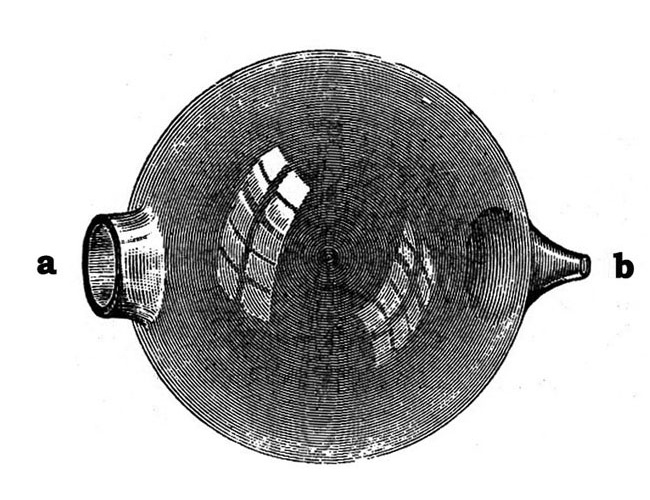
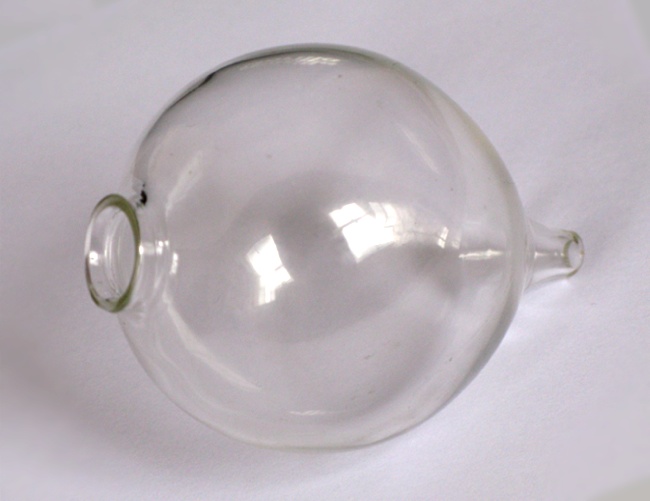
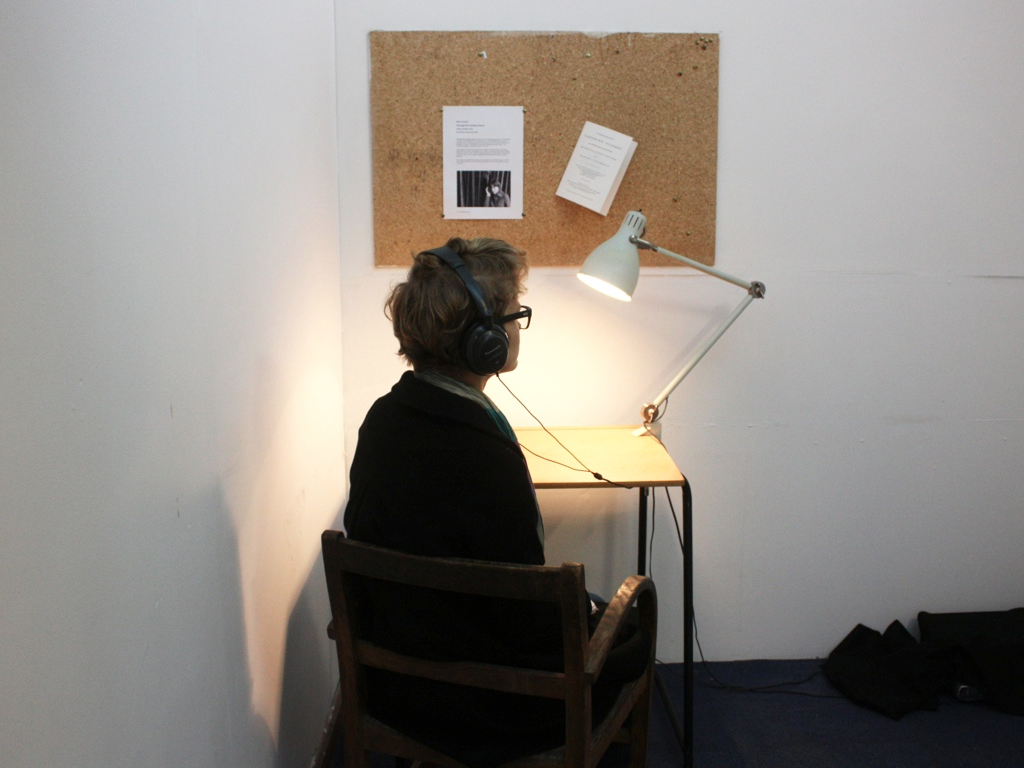 Photograph: Jockel Liess
Photograph: Jockel Liess
![]()
Audiovisual Programme
Hydroacoustic Study
Francisco López and Paul Prudence
excerpt – 6'
AV / Live Cinema, Summer 2010.
Hydroacoustic Study was originally conceived as a live audio-visual performance piece with sound artist Francisco Lopez for a Spatial Sound event organised by Optofonica at the Smart Project Space in Amsterdam, June 2010. It is a live generative cinematic exploration of sonically activated biological events, specifically evolving cellular entities that grow in response to sound vibrations.
shifting view
Jockel Liess
3'43" loop
2010
Sound and video installation
The audio-visual work 'shifting view' is focusing in its foundation on the relation of two basic building blocks of acoustic and visual language, the straight line and the harmonic series.
As an artistic notion, the straight line is the most simplistic tool of expression, and reflects on ideas as fundamental as the horizon, and the concept of infinity. As a mathematical principle, the harmonic series is infinite, and its structure provides the foundation for tonality, harmony and timbre in music.
Both of these elements share initial controlled simplicity in its form, which in the course of creating this work gets systematically broken and fragmented, in order to open up the original strict mathematical geometry, and introduce naturalness, imperfection and asymmetry. This is done by applying a variety of theoretical and mechanical processes, with restraint indeterminacy at its core, to the original model of perfection, and thereby evoking a symbiosis of natural process and human conception, revealing a truer and more beautiful view of live.
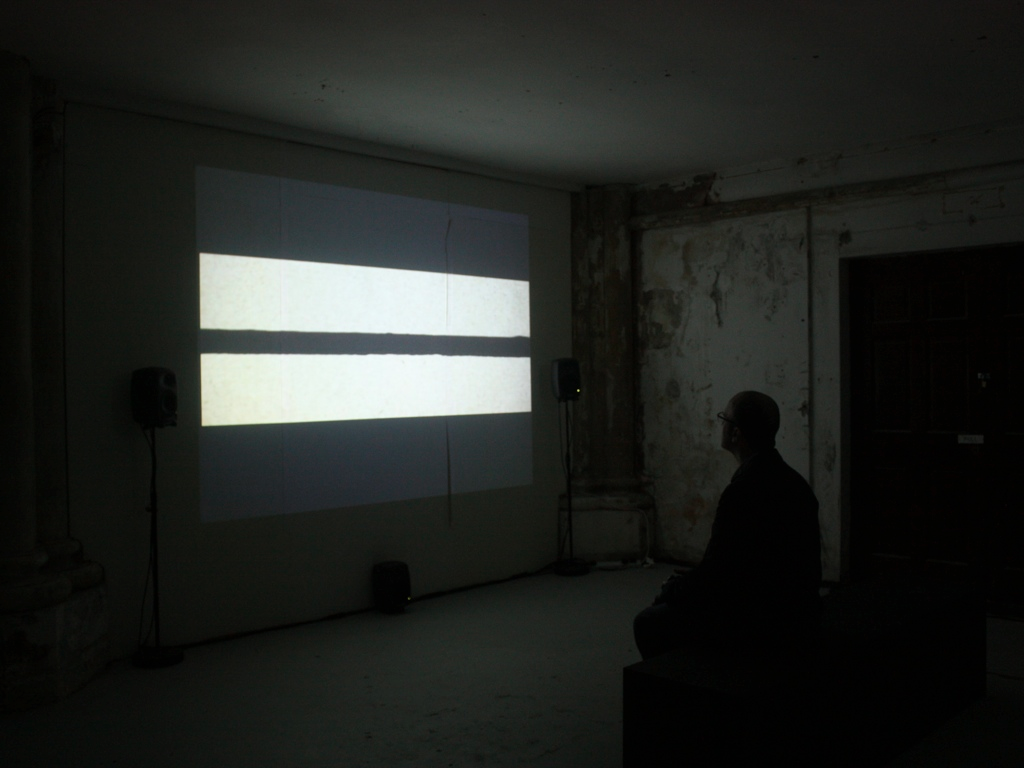 Photograph: Jockel Liess
Photograph: Jockel Liess
Clementine
Tim O'Riley
Soundtrack by Chris Haworth
excerpt - 5'40"
Clementine is a looping animation that features a single orbit around the moon. Rendered from a computer model where planetary positions and lunar surface itself is based on data collected by the Clementine spacecraft which spent a some months orbiting the moon in 1994. The Clementine spacecraft was named after the song, Oh My Darling Clementine, as it would be 'lost and gone forever' once its mission was complete. This forms the over-riding theme of the soundtrack, a long-form algorithmic composition consisting of a generative sequence of sound-atmospheres that emerge and fade over the 118 minute duration.
Shift
Max Hattler
2'50" loop
2012
Using the New Age idea of a 'dimensional shift' as inspiration, Shift combines science fiction themes through abstract, stop motion animation of objects and colour.
A film by Max Hattler.
Sound by David Kamp.
Additional Animation by Mavis Chen, Mia Hattler, Kami Hattler.
An Animate Projects production in association with Lupus Films for Channel 4.
Length: 3'00" (broadcast + festival version)
Sync
Max Hattler
9'00"
2010
Director: Max Hattler
Production: Pavlov E-Lab, Nathalie Beekman, Max Hattler
Scientific Advisors: Eric Bergshoeff, Martha Merrow
Animation: Andreas Thomsen
Music: Dennis van Tilburg
Supported by: Open Workshop dept. of The Animation Workshop, Viborg, DK
A circular looping animation projection installation.
"(...) the film is based on the idea that there is an underlying unchanging synchronisation at the centre of everything; a sync that was decided at the very beginning of time. Everything follows from it, everything is ruled by it: all time, all physics, all life. And all animation." (Max Hattler)
AANAATT
Max Hattler
4'45"
2008
Director: Max Hattler
Producer: Max Hattler
Animation: Max Hattler, Noriko Okaku, Philip Serfaty, Rodrigo Vives
Music: Jemapur
Agency: W+K Tokyo Lab
Creative Director: +cruz
Thanks to: Nick Roericht
The ever-shifting shape of Analogue Futurism. 100% digital-effects free.
Challa
Meital Covo / Ryo Ikeshiro
6'30"
2009
HD Video 5.1 surround sound installation, 6.30 min loop, mixed media
Challa brings together personal, Jewish and western symbols and myths to evoke basic human conditions. The piece was constructed from 4256 still images, depicting a five-hour process of a Challa bread rising in an oven. Visitors are invited to trace their own route through the immersive space, their position affecting both the balance of sonic elements from wood chimes and sleep talking and the sense of intimacy with the bread.
Field Notes From a Mine
A film by Tom Tlalim & Martijn van Boven
fieldnotesfromamine.org
Field Notes From a Mine is an abstract documentary about a data environment. A map of pilgrimage routes in North Africa, and geographical data collected along them, is used as a fundamental score / script for this computer-generated piece. The path crosses 6900 km from an unnamed location in South Sudan, to Marrakech, and is dissected by 9 national borders.
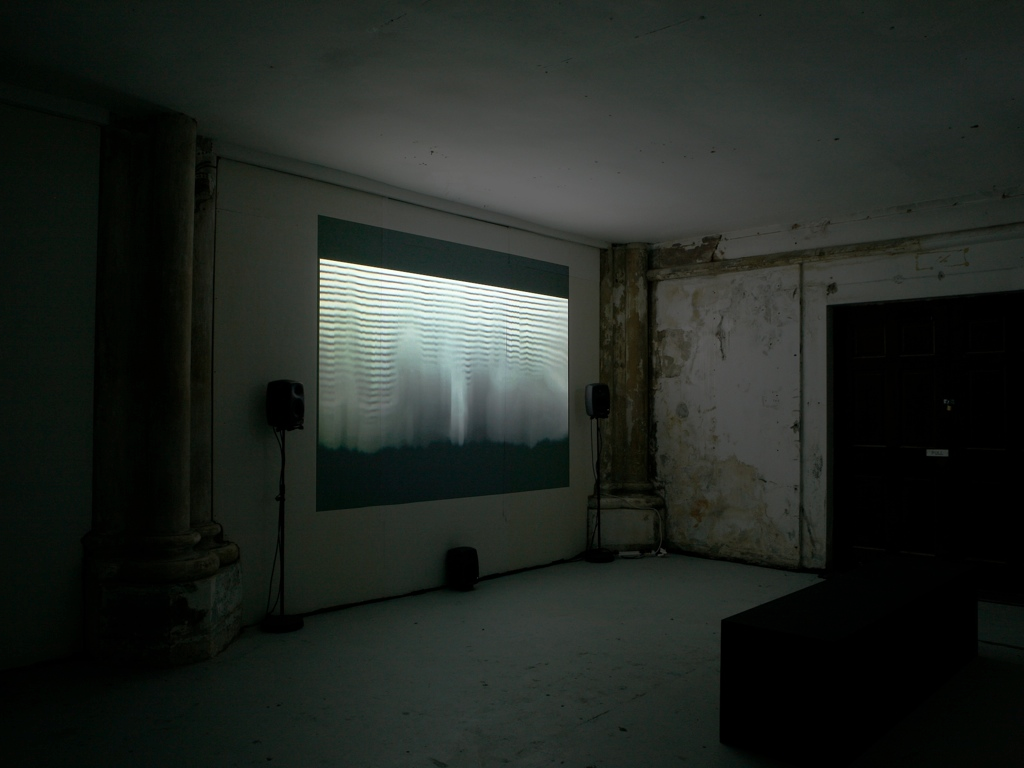 Field Notes From A Mine - Tlalim & van Boven
Field Notes From A Mine - Tlalim & van Boven
Photograph: Shira Klasmer
![]()
Lawrence Upton
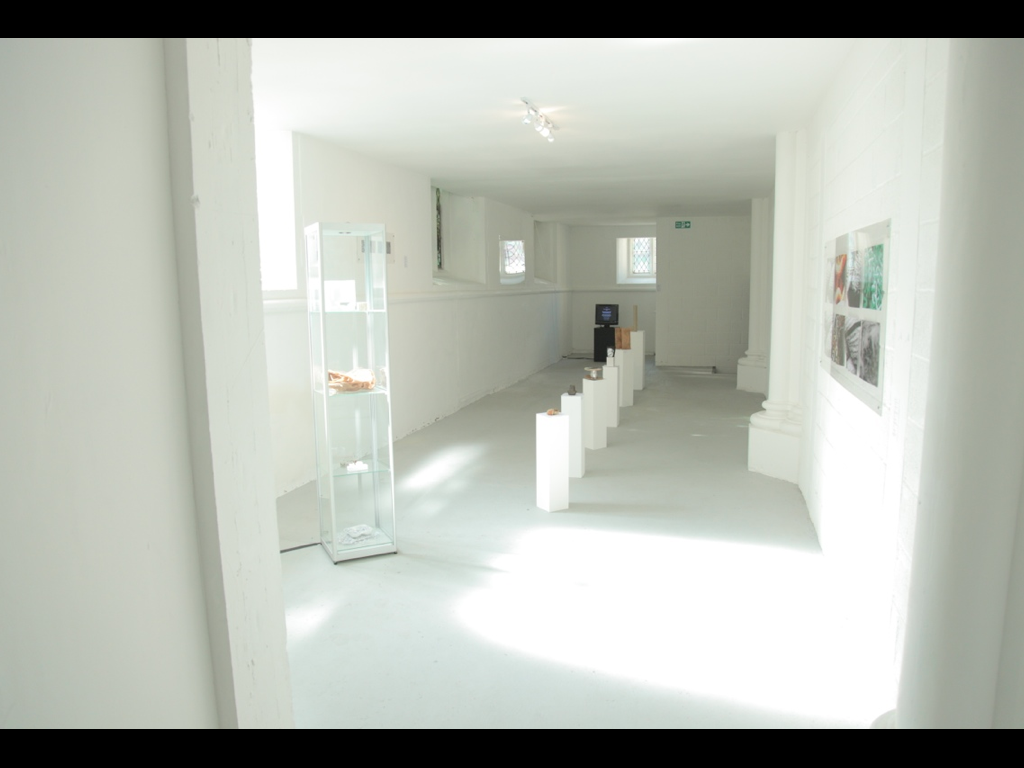
Photograph: William Pine
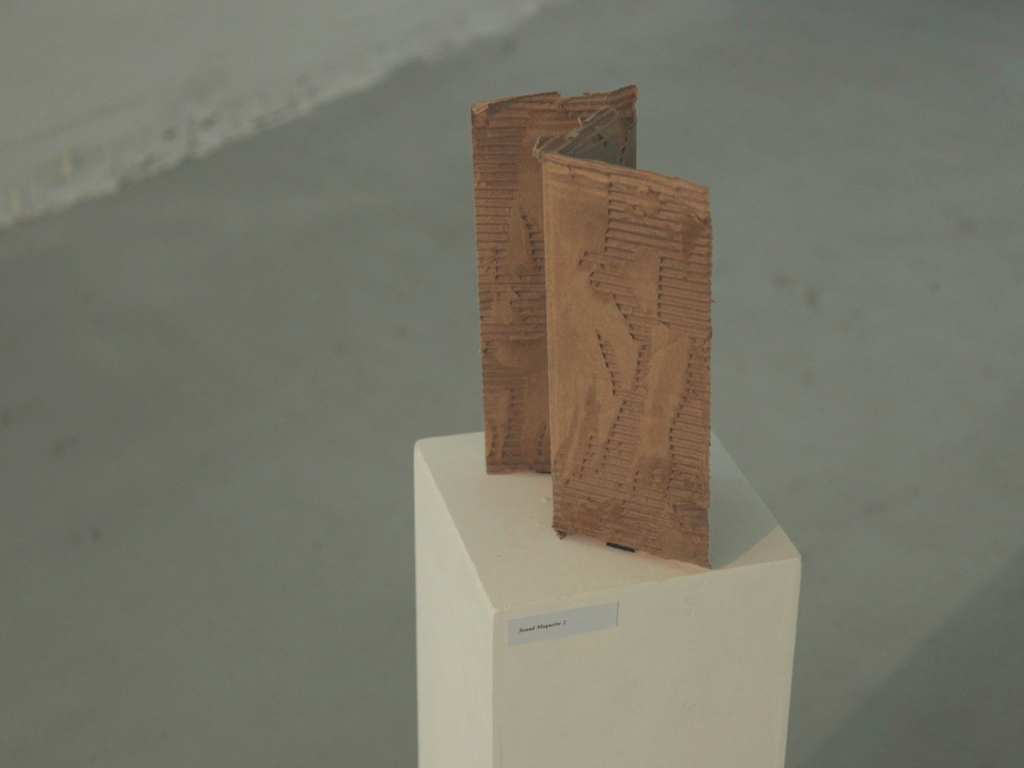 Photograph: William Pine
Photograph: William Pine
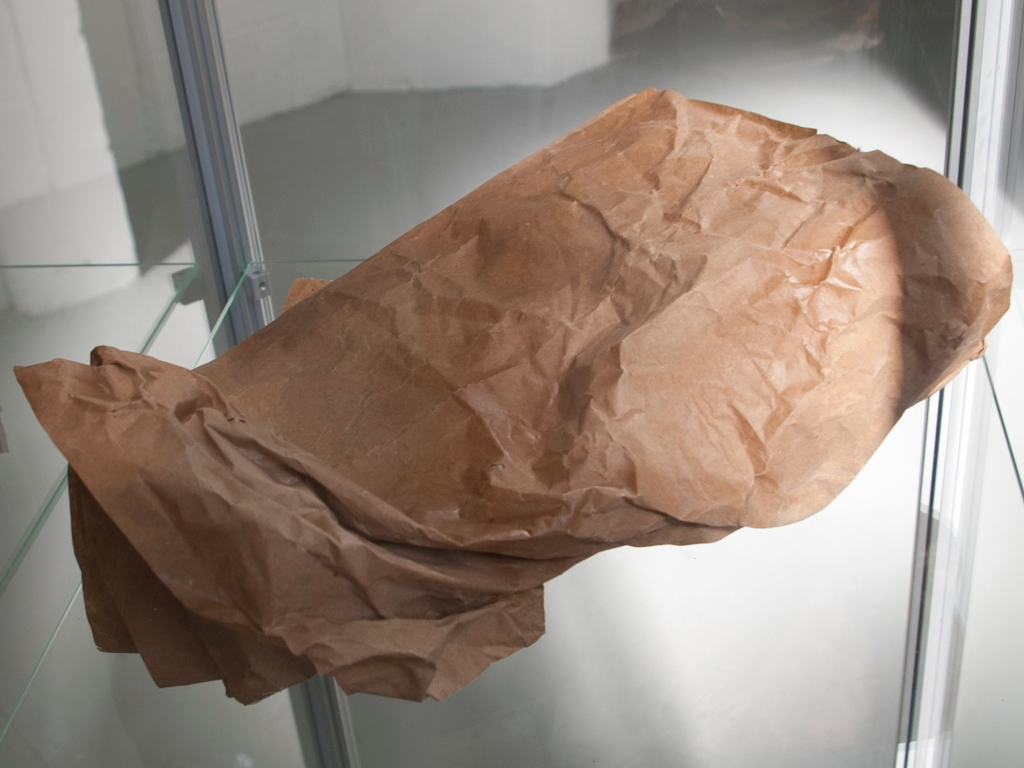 Photograph: James Bulley
Photograph: James Bulley
![]()
iridescent self - Jockel Liess
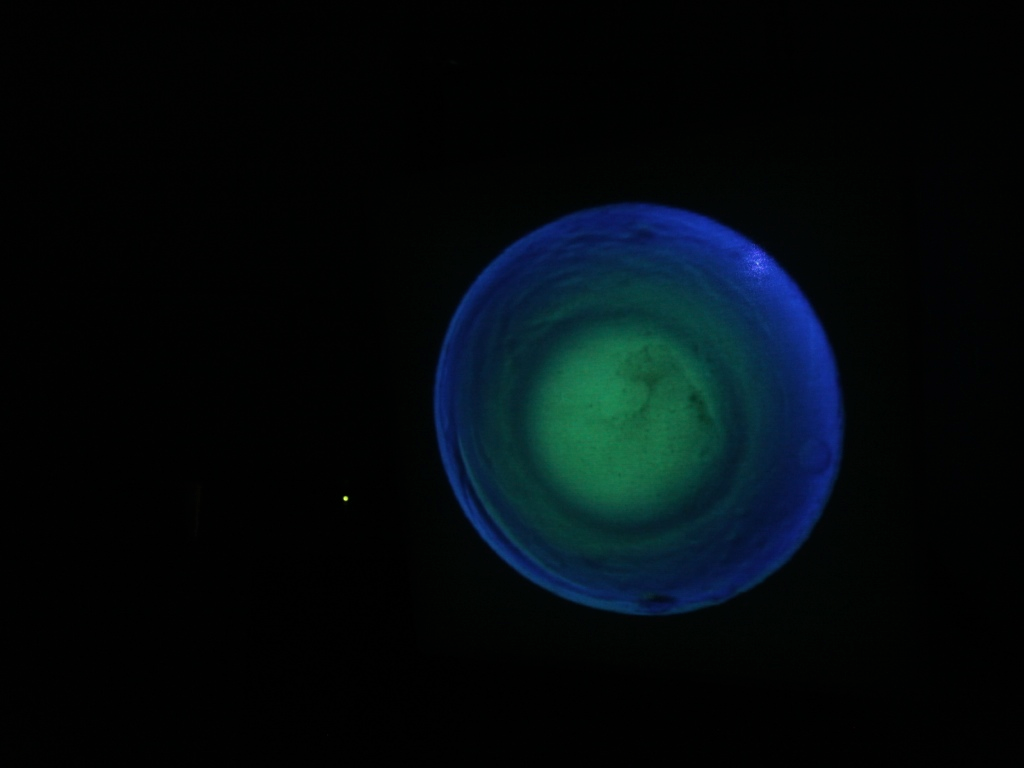 Photograph: William Pine
Photograph: William Pine
‘iridescent self’ is a non-durational generative audio-visual installation. |
influences as well as various ongoing analytical procedures scrutinise the occurring melodic events and certain randomised aspects of the work in order to create a holistic relation between the individual elements.
The objective of this cross analysis and cross influence of different aspects of the piece is the creation of a quasi-fluid system, reflecting on and, to a degree, imitating natural acoustic environments or identities. This means that while the pre determined element in the acoustic range or ‘vocabulary’ produces distinctive acoustic qualities, once the work becomes active the use of these components is indeterminate and develops over time, generating unique outcomes. Sound and image of the piece are to be seen as a continuous visual and acoustic environment combining vivid colour and abstract imagery with rhythmical and melodic elements. Change and development within these predetermined structures is the result of chance operations; external influences as well as various ongoing analytical procedures scrutinise the occurring melodic events and certain randomised aspects of the work in order to create a holistic relation between the individual elements.
The physical element of the work forms an elaborate frame, anchoring the time-based aspect in its current surroundings, by lending the work an almost outer worldly, alien presents. Suspended in space the entity that is ‘iridescent self’ looks down to its audience, observing its spectator and surrounding metaphorically as well as through the use of a web camera. As a reversal of roles, this instinctive dialogue, manifests itself within the blurred boundaries of the observer and the observed and could be symptomatic of an attempt to seemingly stimulating, and portraying the eternally willingness to enter into a dialogue with the world, whilst incapable of articulating in the same language.
|
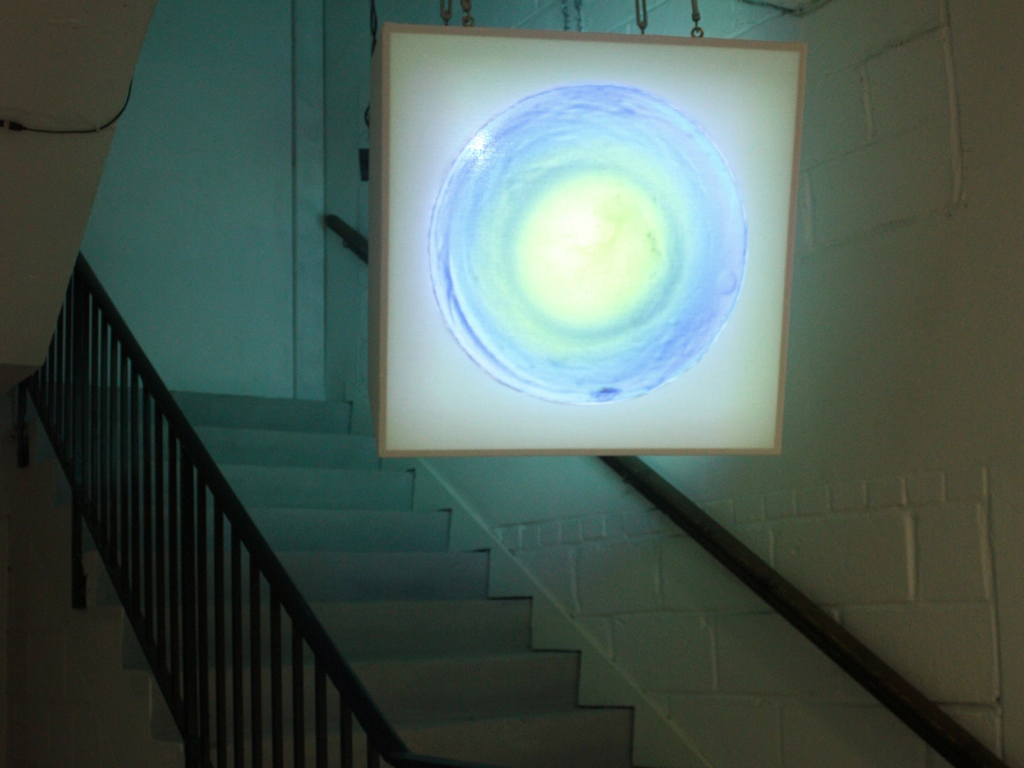 Photograph: Jockel Liess
Photograph: Jockel Liess
![]()
Seminary - Robert Jack
Seminary
With thanks to the Scottish Screen Archive.
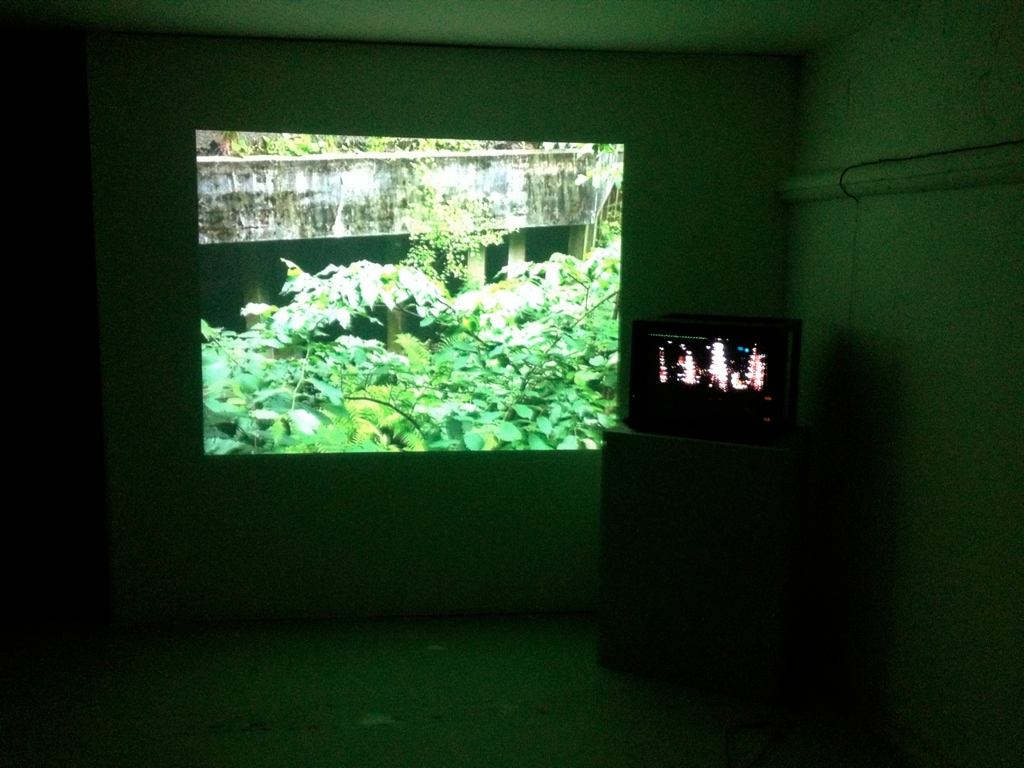 Photograph: Fiorenzo Settimino Palermo
Photograph: Fiorenzo Settimino Palermo
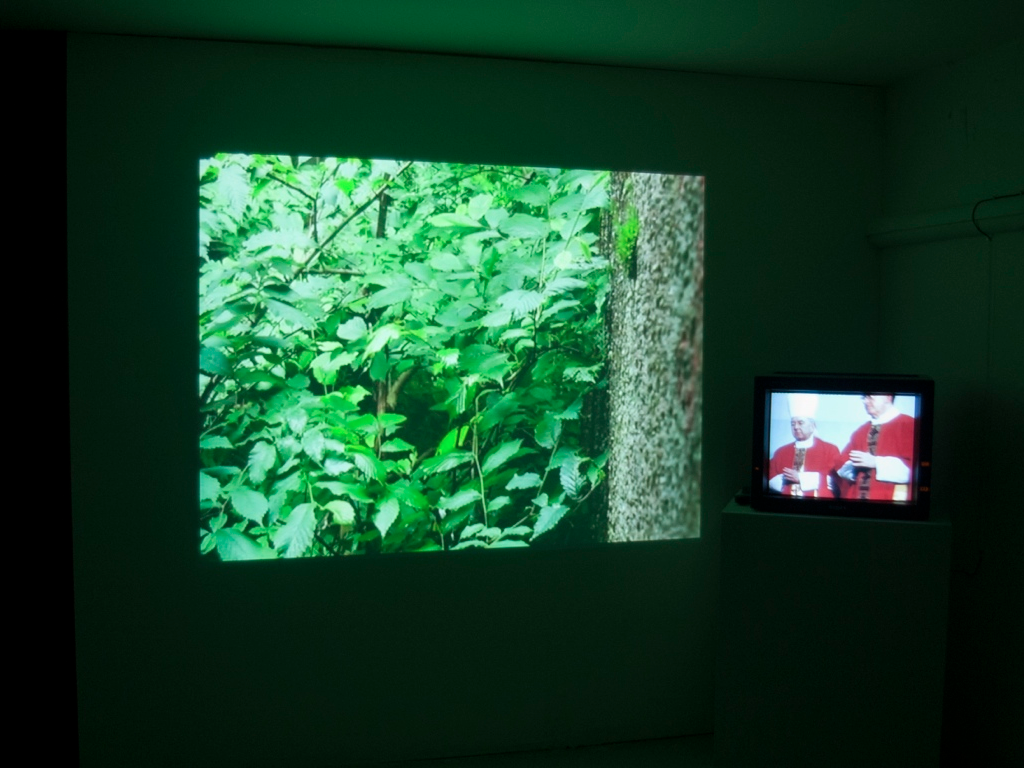 Photograph: Robert Jack
Photograph: Robert Jack
![]()
Soundscape Programme
Curated by Emmanuel Lorien Spinelli
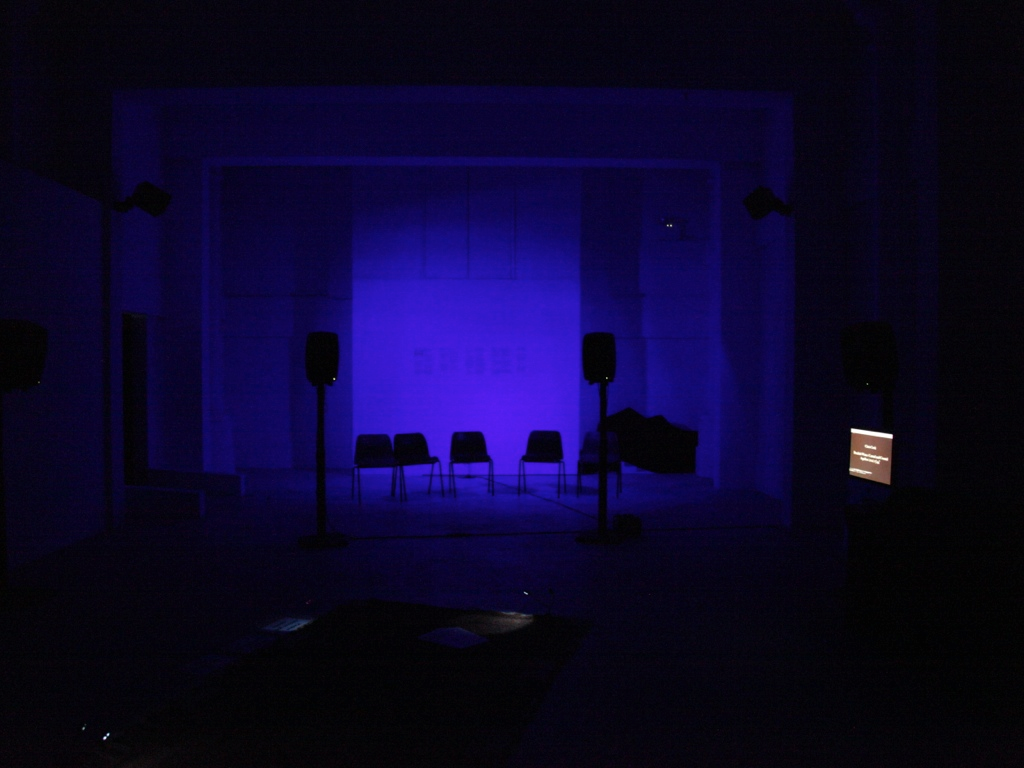 Photograph: William Pine
Photograph: William Pine
Memories of Place
8 channel installation
Marcus Leadley
7’51”
2012
Memories of Place takes the listening practice and sonic aesthetic developed for a site-specific installation at West Bay in Dorset in March 2011 as the starting point for a new work for 8-channel diffusion. The work combines material structured by stochastic processes with composed sequences and is built around a narrative that takes the listener on a journey through a number of different acoustic territories encounter ed during location recording. Field recordings used in the composition have not been extensively processed and represent what the microphones captured on the day. All effects and transitions are created using editing, cross-fades, hard cuts, juxtaposition and superimposition. Many of the spatial movements within the 8-channel environment are intended to mirror the effects that coastal gusts and squalls can have on the apparent location and direction of sound. The work does not seek to replicate the quotidian; it is a creative attempt at the sonification of auditory memory – where component sounds and their relationships might take on archetypal or broader
sensory significance.
Background note: during the course of my PhD I have been developing a site-specific sound installation practice as a creative method for investigating the acoustic aspect of place. This has been a wide-ranging exploration moving through urban, rural, coastal and campestral milieu. To date, I have conducted nine installations. My approach to site begins with listening, walking and mapping. This leads to the field recording of specific soundscapes, individual acoustic features and the sounding of objects in the environment to expose acoustic potentials embedded in the landscape. 30-40 of the most representative sound files, ranging in duration from a few seconds to a few minutes, are identified and used to create an archive. Theses files are combined live using a custom Max/MPS patch that generates a constantly evolving, mediatised version of the quotidian soundscape. Participants experience the work at the location where the recordings were made using wireless headphones. The experience of this non-linear soundscape/soundtrack, where the relationships between cause and effect are subverted, provides an alternative point of audition for reflection on familiar sonic environments.
Inside Out/Outside In
8 channel installation
Marcus Leadley
9’11”
2012
This is an 8-channel spatialisation of the original stereo Max output from my most recent installation at the Whitstable Biennale in September 2012. While the work represents the linear output, the raw material has been edited to create a more focussed rendition and better showcase the overall creative potential of combining 42 separate field recordings with 7-voice polyphony. The orchestration of sounds is achieved by allowing random processes to determine sound file choice and combination within a timing and delivery framework created by a text score – which is programmed into the patch.
Both Inside Out/Outside In and the Whitstable Biennale installation represent a new direction for my practice as the exploration of the acoustic environment changes its focus; away from airborne sound and the quotidian to the ‘hidden sounds’ that can be revealed using hydrophones, contact and induction coil microphones. Hence the work features underwater sounds, sound transmitted through solid materials and the sonification of electromagnetic emanations.
only when you’re nameless
8 channel installation
Portia Winters
20’46”
2012
‘only when you’re nameless’ is a sound map of a road trip around Iceland. In July 2012 I travelled from Reykjavik up through Stykkishólmur, Breiðafjörður bay and around the Vestfirðir. It also includes excerpts of conversations with my travelling companion and her 3 year old daughter and with the philosopher Ólafur Páll Jónsson, concerning the relationship between human beings and nature. The project wonders whether the act of listening can enhance our chances of re-identifying the teleology of nature’s aesthetic, and reveal the real properties of the world and our own nature to be more complexly bound than our manner of consumption and categorisation admits. In doing so, we might nurture a more sophisticated relationship with nature and therefore ourselves, and begin to step up from purpose-led and consequently forever-dissatisfied culture, where nature itself tends to be identified in terms of what it can do for us. Instead we might celebrate and reside in the now (despite the fact that the now is tricky, because it’s always over).
“To have a musical experience is not just a momentary sensation or feeling caused by sounds in our vicinity. It is not just what we hear, but also what becomes of what we hear. What we hear may change the way in which we relate to the world, not just in a particular moment but in the future. So, in order to account for musical experience we would have to consider how we relate to things, what our values are, and how these get projected into the future. In short, experience is not just something which hits us, so to speak, but also something which changes us. To be able to have experience, is to be able to be educated.” -Ólafur Páll Jónsson.
gardenvoice
8 channel installation
Portia Winters
11’46”
2011
gardenvoice is a piece in two parts for environmental sounds and voice. The environmental recordings were made in my old back garden in North London on two occasions last autumn, (a sunny Sunday in the afternoon and a rainy Tuesday at midnight), shortly before moving to my new home in South London, where I recorded myself (on a Thursday evening) improvising in the empty bedroom. After cutting and re-placing the recorded materials, for example dramatising leaves and ladders and layering butcher’s fans, new cells of sonic activity emerged, making paintings and small sonic eulogies and celebrations for the unfolding environments of my old garden space and my new home space.
“Nature has no outline, but imagination has.”
William Blake
Portia Winters is an experimental vocalist and musician working with song, concrete sound, field recordings and electronics.
Suomalainen äänitkutkielma nro 1.1
8 channel installation
Ian Stonehouse
10’00”
2010
Suomalainen äänitkutkielma nro 1.1 (‘Finnish Sound Study #1.1’) utilises recordings made in Finland between 2007 and 2010, filters and processed in AudioSculpt and MetaSynth software. The recordings were made primarily in Helsinki - flags fluttering at Suomenlinna sea fortress, sea ice scraping in Lauttasaari, swifts calling in Töölö, walking in deep in snow, bells at Vanha kirkko (church), traffic/tram sounds, a street musician, seagulls, sea lapping - as well as in Iitiä, near Lappeenranta in South Karelia - rain falling into a water barrel, a crow calling, wind in trees, drawing water from a well. This is a shorter extract from a longer work, focussed in part on the congruence between the filtered sea ice and swifts, which were recorded at opposite ends of the year and the thermometer. This (interim) version includes a part for cantle, a traditional Finnish stringed instrument, echoing some of the resonances within the flags and sea ice.
Ian Stonehouse is Head of the Electronic Music Studio in the Dept. of Music at Goldsmiths.
sanitary tones: air#1
8 channel installation
John Levack Drever
(excerpt from the 60 minute environmental sound work)
2012
A sonic study of the sound energy of a Dyson Airblade™. The device was recorded in BRE’s anechoic chamber, the largest anechoic chamber in the country. This creative study relates to a larger social and scientific project exploring the noise impact of ultra-fast, cold air, ‘ecological’ hand dryers in publicly accessible toilets on the full range of users, including children and those with hyperacusis.
Thanks to Vicki Bennett, Becca Lawrence, Tim Steiner, Anya Ustaszewski and Ian West.
Brackish Water: Golan Heights & the Mountain Aquifer
8 channel installation
Chris Cook
18’54”
2012
Brackish Water is a collection of field recordings made recently in the Golan Heights, the West Bank and Israel. It has two parts, both tracing southwards through two aquifer regions each. Brackish water is salty and/ or polluted, resulting from heavy use of sources.
This part moves through farmland and Jordan River tributaries near the northern edge of the Golan, down to the Sea of Galilee and Gamla Nature Reserve in Israel. It then follows the southern stretch of the Mountain Aquifer from Jerusalem to the Dead Sea, both in the West Bank and Israel.
Brackish Water: Carmel and Coastal Aquifers
8 channel installation
Chris Cook
17’44”
2012
Brackish Water is a collection of field recordings made recently in the Golan Heights, the West Bank and Israel. It has two parts, both tracing southwards through two aquifer regions each. Brackish water is salty and/ or polluted, resulting from heavy use of sources.
This part includes Akka and Haifa on the Mediterranean coast, and Nazareth between the Carmel and Galilee regions. The second half focuses on Tel Aviv and Jaffa, both in the densely populated strip on top of the Coastal Aquifer, which continues south through Gaza and into Egypt.
Nos.
8 channel installation
Jake Williams
c.10’
2011
Electroacoustic/drone piece made from multi-channel recordings of friends taking Nitrous Oxide on 4 December 2011, a Moog synth and a sine wave. Explores internal vs external sound experience and drug use as a social ritual.
Eargates
8 channel installation
Jake Williams
c.17’
2012
Eargates is an electroacoustic soundscape made from recordings of 7 church services around London. It explores varied forms of Christian rituals, from the intimate to the grandiose, their effects and meaning, and the spaces in which they occur, all from the perspective of a non-believer. The piece is not intended as a statement or critique of religion. Rather, it explores and tries to capture snatches of the emotions evoked by religious rituals themselves, rather than the meanings attached to them – calm, meditative reflection, unease, joy, melancholy, embarrassment. The traditional editing techniques of musique concrète are used to create an abstract soundscape rather than a documentary. Loops of singing, chanting, organ, room tones and preaching slowly evolve and are layered over each other in rounds, with no recording ever heard alone.
Jake Williams has worked with many aspects of electronic music over the last 10 years, writing / producing for Warp Records, Lo Recordings, !K7 and Process amongst others, toured extensively as part of live bands and a DJ, lectured on Ableton Live and has written music and sound design for television and award winning short films. He has recently completed a Masters at Goldsmiths University, focusing on electroacoustic composition, performance and installation based around ideas of ritual and internal vs. external sound experience. Recent performances and exhibitions of his work have included the Southbank Centre, NTS Radio, SonicCueB and the Sho-Zyg exhibition at St James Church, New Cross.
Lands and Geontypes mov. II: Anseriformes Twins
8 channel installation
Emmanuel Spinelli
17’35”
2007
Rosie Richardson
Anseriformes Circus: Ducks & Birds
Thomas Richardson
Drone Early Morning
Charles Richardson
The sound-subjects for this piece are the Richardson brothers and their mother, Rosie. Being twins, the boys first developed a “personal language”, a way of communicating with each other peculiar to them which no one else would understand. Therefore their ability to learn English was altered and they did not speak until they were almost four years old. “They both said the word Duck, and then they never learnt another word...’’ The different textures are made up of field recordings around the city of Bath, a duck pond, birds, their family house, personal belongings, electrical equipments, a circus, as well as family archives found on location and recorded on tape.
Electro+ (Orastie)
8 channel installation
Emmanuel Spinelli
16’58’’
2012
Part of the ongoing project Lands and Genotypes (dealing with the perception of acousmatic identities and traces through postwar Europe and in particular in relation to the Holocaust), Electro+ started as a collaboration with Romanian artists Nicu Ilfoveanu and Agnes Birebent and explores the soundscape of south-western Transylvania: all around Orastie.
The material for Electro+ was gathered following 3 different trajectories:
1 - A touristic guide to non-touristic parts of Romania - a visit of the hidden histories where no one ever goes. A poet, a scientist, a farmer, a footballer, a postcard may have been born there, no-one really knows. Organised tour of derelict factories, stations, hotels, museums, graveyards, bars.
2 - The production of postcards and anecdotes; “they are deaf as i am blind”: name of a restaurant (Ukrainian border); mistranslation on the menu: the beef tongue stew is called: “the language is boiled”; in 2005 a small group from the Battersea Dog’s Home drove a van all the way to Bucharest to rescue a few strays who were being slaughtered (EU fundings used to “solve” Romania’s “dog problem”). On their return, I interviewed the dogs in London. In 2011, I sent the recording back to Romania as a guide to part of the journey through Or??tie. They are featured in the piece, mixed with the others...
3 - For a Romanian Oresteia. Aeschylus’ tragedy marks the transition from the old system to the new one. Not just politically but also in the shift from the practice of personal vendetta to a system of litigation. Orastie, a town named after Agamemnon’s son (Orestes’ sister is called Electra), and home of the Dacian fortresses, becomes the starting point of the search for traces. Traces of change, of the transition that happened in Romania, from the old system to a new one. On the main street: a building called “Electro+”.
Field recordings from: Orastie.Babadag, Macin (Dobrogea): Emmanel Spinelli. No-one apart from a few unaccompanied children. Football: night training. The bar: seasoned drinkers playing backgammon...
Baltati, Botosani, Vorniceni, Tataraseni, Zece Prajini, Dorohoi (Moldavia): Derelict train station, derelict factory, Jewish cemetery. Dorohoi, prior to WWII, had a very large Jewish population. They have all practically disappeared, murdered in the village by the local population, or deported to Transnistria. No traces of their habitations. A memorial was to be built, instead we find an aquarium, only one thing to do: read the fishes’ names. Later, a family of three; one of them just passed away. Her sister and the two undertakers tell us about their “territory”, their life as one of the few remaining Jewish families in the area...
Focsani, Resita, Câmpulung, Anina, Caracal, Târgu Jiu The Table of Silence (Valachie & Banat): An old train, Gipsy bands, wedding, roadworks everywhere, horse carts, stray dogs.
Bucharest: a car passing by announces the arrival of the circus.
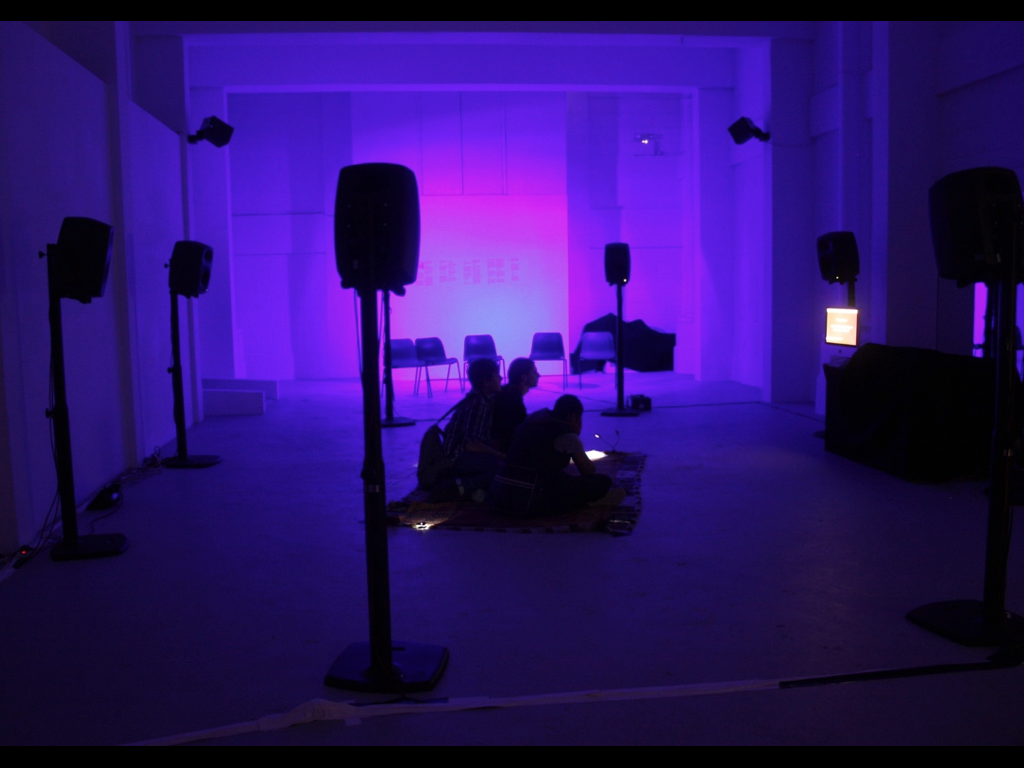 Photograph: Jockel Liess
Photograph: Jockel Liess
Air Traffic
8 channel installation
Dawn Scarfe
c.15’
2006
Air Traffic was recorded from a window, using contact microphones placed on a homemade Aeolian harp. The piece documents the action of the air on the strings of the harp, as well as the sound of planes
flying overhead in the greater distance. It explores ways in which sound can reveal activity in the atmosphere. Aeolian harps are an ancient way of sonifying the changing strength of the wind, producing
a mournful sound which rises and falls with the speed and direction of the airflow. As planes approach and recede from us, their sound rises and falls in pitch due to the Doppler effect. Their sound can be intensified and rendered more ominous by meteorological conditions such as low cloud cover which causes increased reflection.
http://www.dawnscarfe.co.uk
Do You Hear What I Hear?
8 channel installation
Dawn Scarfe
10’ 00’’
[extract]
2010
The audio for this piece was collected by microphones placed inside eight tuned spherical glass instruments called ‘Listening Glasses’. These were positioned by the side of a busy road to stratify the sound into eight distinctly tuned streams. Each glass had been calibrated to a particular musical tone, and amplified this tone if it sounded in the surrounding air through a process of ‘sympathetic resonance’. The eight streams of audio were then arranged and diffused through an eight speaker system located in a public passageway in Vienna.
This installation forms part of a series of works which explore the act of listening through the ‘lens’ of Listening Glasses. Scientist Herman von Helmholtz (1821-94) developed glass resonators to identify
subtle partial tones in the sound of musical instruments. He confessed to taking them outside of his laboratory and listening for their tones in ‘noises’ such as the rumbling of carriages, the whistling of wind
and the splashing and seething of water. The thought of Helmholtz embarking on these listening excursions inspired me to make a new series of Listening Glasses and to try to discover musical tones in the sound of my environment.
http://www.dawnscarfe.co.uk
Does the bus stop here?
8 channel installation
Nabil Ahmed
c.19’
2012
‘Does the bus stop here?’ is a sound ethnography of mosques in three cities, London, Paris and Istanbul. The inside ambient sounds were recorded in La Villette mosque in a converted bus hangar on the outskirts of Paris, Riquet mosque in the basement of a social housing block located in the 19th district, the central mosque of Paris, and the East London mosque. The sounds we hear on the first part of the piece are reverberations of rain falling on the metallic roof of the bus hangar, the voice of many Malians in a crowded space, creaky chairs of old Bengali men praying, and the hypnotic chant of hundreds reciting from the Quran in unison during heavy rain under a large dome. In the second part we take a ferry journey across the Bosphorus in Istanbul, from under the roar of the engine the unmistakable call to prayer emerges as the boat nears shore.
The Devil’s Arse
8 channel installation
Tom Slater
15’12”
2010
“The Devil’s Arse” is a soundscape composition of 15’12’’ and takes its name from the source of its sound world. It is composed entirely of field recordings taken from a series of caverns in Cumbria known locally as The Devil’s Arse. A phenomenology of environment and place is composed of essential qualities such as sound, topography, light and spatial qualities, which promote a particular character. Unlike the objects of visual perception, which generally have physical form, and therefore permanence, the world of sound is fleeting and supports a way of knowing much different than that of vision. In this case of an 18th century man made subterranean world sight is diminished by extremely low light levels and is no longer dominant. An aural way of knowing which differs from that of vision is suddenly enhanced, it is the interplay of sound and spatial qualities of this particular place that create the perceived environment.
Cusp
8 channel installation
Tom Slater
13’22”
2010
CUSP is a soundscape composition of 13’22” and is composed entirely of field recordings gathered from two common sociocultural situations; refugees gathering at a relief point for food, medical supplies and blankets and, a celebratory dinner at a family home. Each of these seems to lie at opposite ends of a spectrum of a sense of place.
Space is to place what house is to home, in that unlike their counterparts home and place are not self contained but emerge form their dialectic interaction along a series of binary oppositions. The fundamental difference between the locations of the recordings is the sense of inside and outside, shelter and exposure. This is the dialectic nature of our understanding of place and placelessness, home and homelessness. Our sense of home is heightened when we are warm in bed and yet we can hear the rain and wind on the windows, the sense of cold outside makes warmth meaningful and it is our sense of control over the future that makes the uncertain present more or less threatening.
Three
8 channel installation
Martin Clarke
07’00’’
2009
Wszerzecz, Poland. Single point stereo recording.
Selardalur
8 channel installation
Martin Clarke
04’27’’
2012
West Fjords, Iceland. Layered stereo recordings.
Martin Clarke (1978) is a UK based composer and sound recordist. His work makes extensive use of environmental sound and video material to create layered, abstract, formal spaces which are often representational in appearance and have been screened, performed, installed and broadcast internationally in concert, at festivals and on radio. His work as a sound recordist has included documentaries, TV drama, commercials, features and sound effects recording. Martin studied composition with Robert Dow at the University of Edinburgh, and completed his PhD with Jonty Harrison at the University of Birmingham in 2008. He currently lives in London.
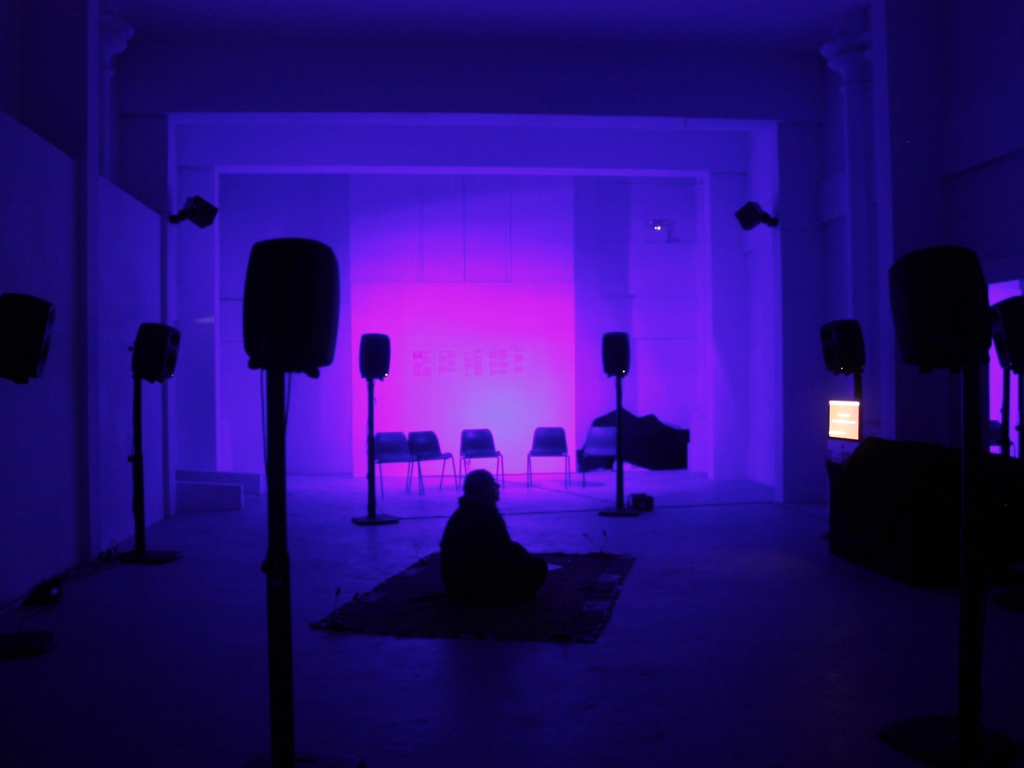 Photograph: Jockel Liess
Photograph: Jockel Liess
![]()
Film Programme
Amir
John Baily
1985
In 1985, at the height of the war between the USSR-backed communist government and the US-supported mujahideen, ethnomusicologist John Baily travelled to Peshawar to make a film about Afghan musicians in exile. There he met his old friend Amir Mohammad, a player of the rubab lute. The film is a journey into Amir’s life: material, musical, and emotional. It reveals: the material condition of refugees not living in camps; the music business and the lives of working musicians; aspects of Pashtun culture as revealed in Shah Wali’s political songs; and a Pashtun wedding celebration with the firing of guns. Amir won a Prix spécial de jury at the Bilan du Film Ethnographique in Paris, 1985, and a prize from the American Anthropological Association, 1989. In 2011, Amir was selected as one of the outstanding films to have been shown in the Jean Rouch International Film during the festival’s 30 year history, and was screened in the retrospective Trente Ans, Trente Films in Paris.
Snow
Geoffrey Jones
7’47”
1963
Comprising train and track footage quickly shot just before a heavy winter’s snowfall was melting, the award-winning classic that emerged from the cutting-room compresses British Rail’s dedication to blizzard-battling into a thrilling eight-minute montage cut to music by Daphne Oram. Tough-as-boots workers struggling to keep the line clear are counterpointed with passengers’ buffet-car comforts. In a mere half-dozen films released between 1959 and 1975, director Geoffrey Jones revealed himself as an outstanding talent, embracing industrial filmmaking as consistent with a personal style, blending movement and sound into a joyous, rhythmic whole. Brilliantly aided by Wolfgang Suschitzky’s shimmering camerawork, the Oscar-nominated ‘Snow’ is Jones’ masterpiece. It’s crisply invigorating enough to induce brief amnesia about our trains’ notorious inability to cope with the white stuff - then and now. (Patrick Russell)
Damo Suzuki’s Network – Born out of Chaos
Johanna Bramli
Since 2003, Damo Suzuki has been on a musical and collaborative journey, travelling around the world to ‘instantly compose’ with local ‘sound carriers’. Since then, he has developed a network of international musicians and artists which to this day, adds up to over 4000 performers. I had the chance to follow Damo in this journey from February to March 2011 to make Damo Suzuki’s Network – Born out of Chaos, a short documentary I shot in Brixton, Brighton and Berlin.
Alapana: four views of movement in music
Lara Pearson
A film set in Srirangam, Tamil Nadu, exploring gesture, movement, and shape in Carnatic music through the lessons and performances of the violinist, T.K.V. Ramanujacharlu.
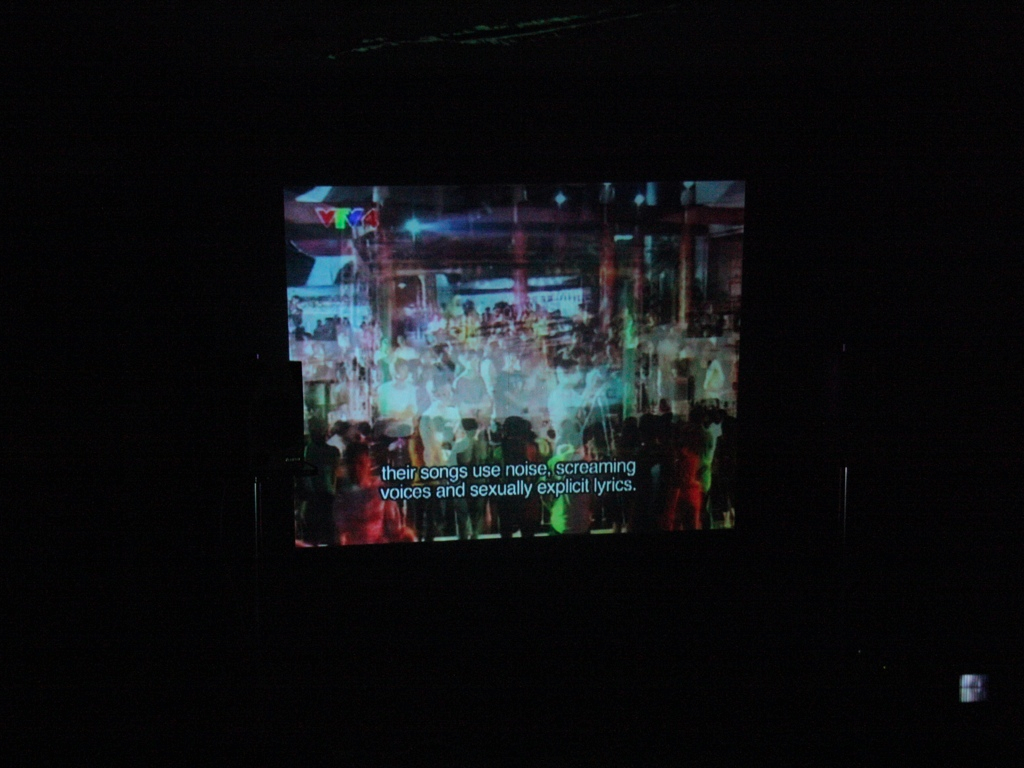
Photograph: William Pine
‘Hanoi Eclipse: The Music of Dai Lam Linh’
Directed by Barley Norton
56’
2010
Hanoi Eclipse follows the challenges faced by the controversial Vietnamese band Dai Lam Linh. With vivid footage of the band working in the city of Hanoi, the film documents the recording of Dai Lam Linh’s debut album and features an album-launch concert in the prestigious Hanoi Opera House. Followed by scandal at every turn for their experimental sound and their use of sexually explicit lyrics, the band have dared to flout taboos and fight for their creative freedom. Dai Lam Linh’s story of creative, political and financial struggle reveals what it is like to be a contemporary musician in a one-party state where cultural expression is tightly controlled.
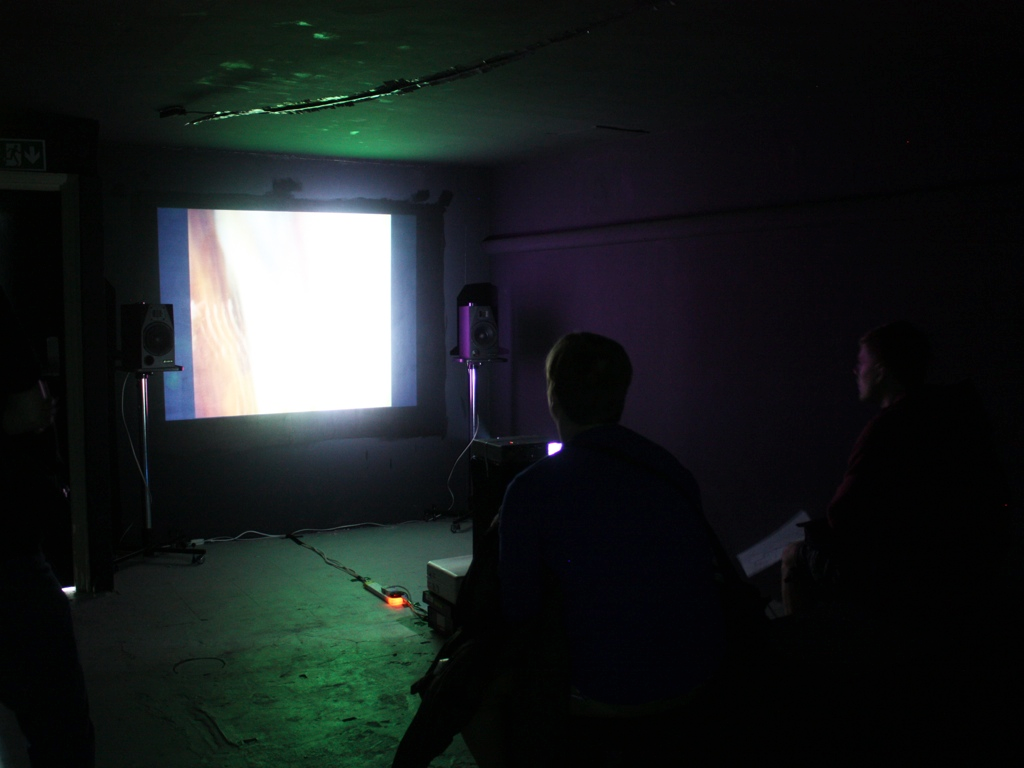 Photograph: Jockel Liess
Photograph: Jockel Liess
![]()
Memorial Chimes Part 1 & 2 - Kathrine Sandys
These two pieces form the bookends of the three month long Cultural Olympiad project - Cargoes, for the East Midlands. The project was a collective of artists responding to each others work, along the canals of the East Midlands. Memorial Chimes Part 1 initiated the project in Loughborough, celebrating the history of the Taylors Bellfoundry and the town's carillon and war memorial. Elgar's Memorial Chimes was played and the recording and waveform printouts transferred to the awaiting canal boats to be carried through the region.
As a final response to the other art works and the journey, recordings of the regions historic textiles industry, canal journey and wartime radio communications between Beaumanor Hall and Bletchley Park, were midi transposed into Memorial Chimes Part 2 - a new piece of music for the carillon and corresponding jacquard loom cards, encoded from the score. The piece was played as the olympic torch was carried through Loughborough on the final day of the project.
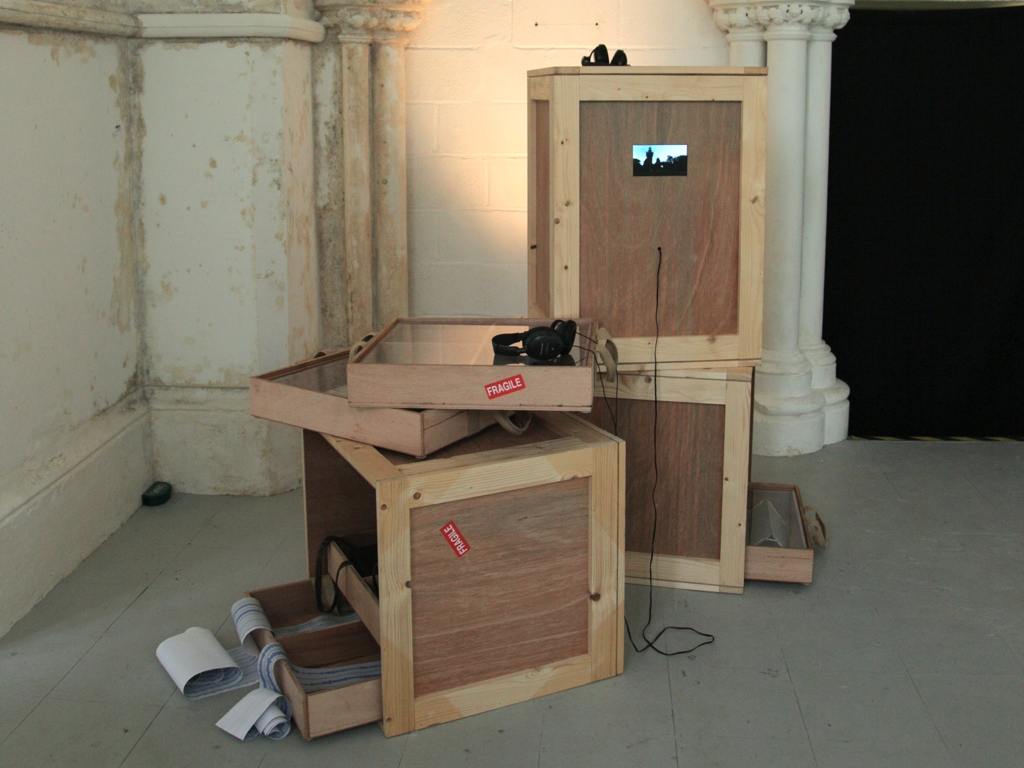 Photograph: William Pine
Photograph: William Pine
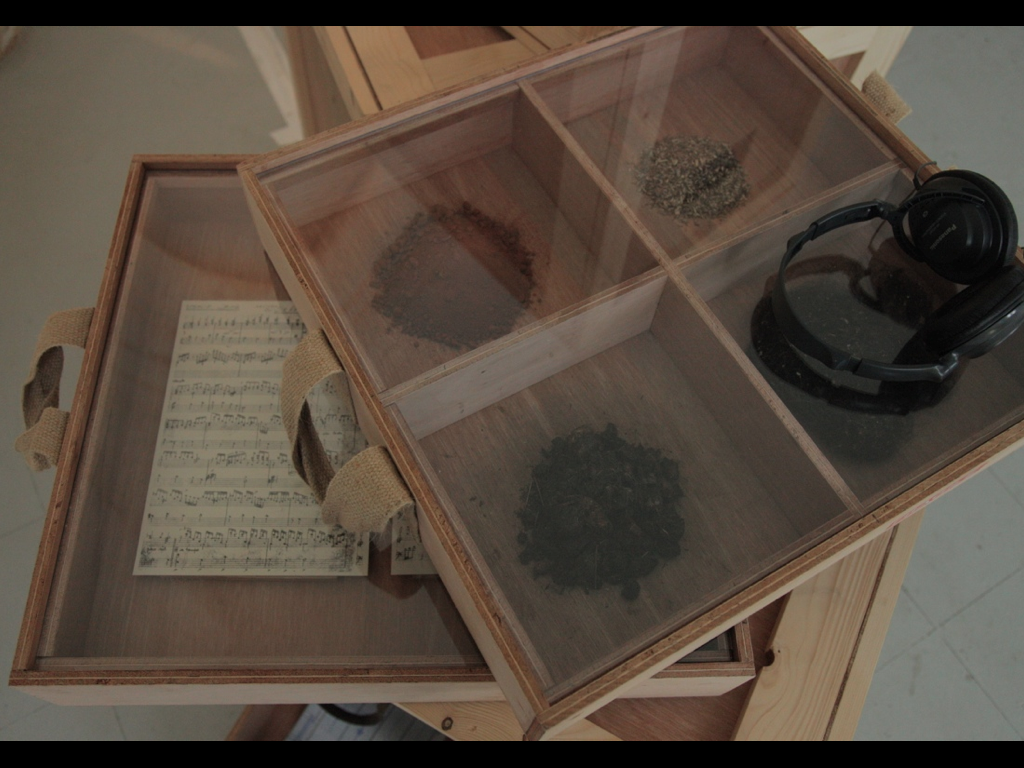 Photograph: William Pine
Photograph: William Pine
![]()
Radio Reconstructions - Jones/Bulley
Radio Reconstructions is a sound installation which use indeterminate radio broadcasts as its raw material.
The installation is structured by a notated score, which controls its rhythm, dynamics and melodic contour over time. The audio elements used to enact this score are selected in real-time from unknown radio transmissions, by an autonomous software system which is continuously scanning the radio waves in search of similar fragments of audio. Using a technique known as audio mosaicing, hundreds of these fragments are played back in an attempt to reconstruct the original score.
The result is a piece whose timbre is ever-shifting, and contingent on the content of countless radio streams from around the globe.
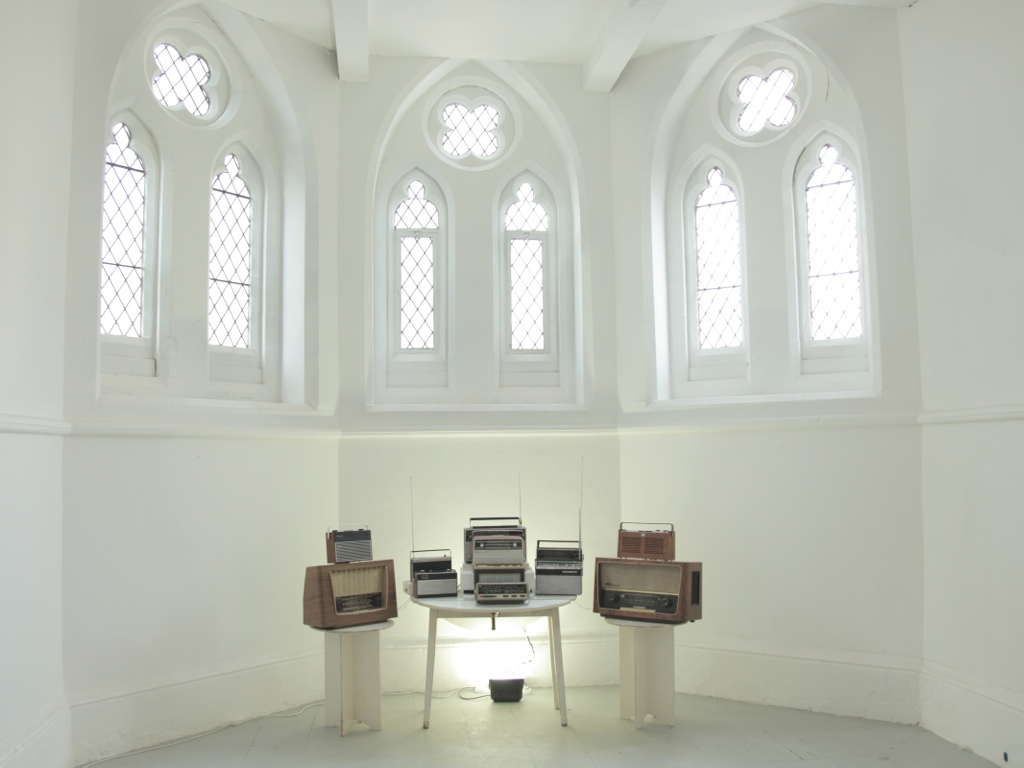 Photograph: William Pine
Photograph: William Pine
Curators
James Bulley & Kathrine Sandys
Co-curators
Ryo Ikeshiro
Tom Mudd
Fiorenzo Settimio Palermo
Tom Richards
Emmanuel Lorien Spinelli
Ian Stonehouse
Graphic Design
Joe Hales
Performance Lighting Designers
Agostina Califano
Jonander Olaeta Duranda
Katrin Padel
Sho-Zyg is supported by Goldsmiths Sound Practice Research.
With sincere gratitude to;
The British Library
The Daphne Oram Trust
Goldsmiths Graduate School
Goldsmiths Special Collections
Rose Bruford College of Theatre and Performance
The Science Museum
Jacqueline Cooke
Pam Davies
John Levack Drever
Mick Grierson
Pavla Heath
Lesley Hewings
Ian Stonehouse
Terry Weller
Simon Wheeler

